中医专业英语课后短语及句子翻译
中医英语翻译重点
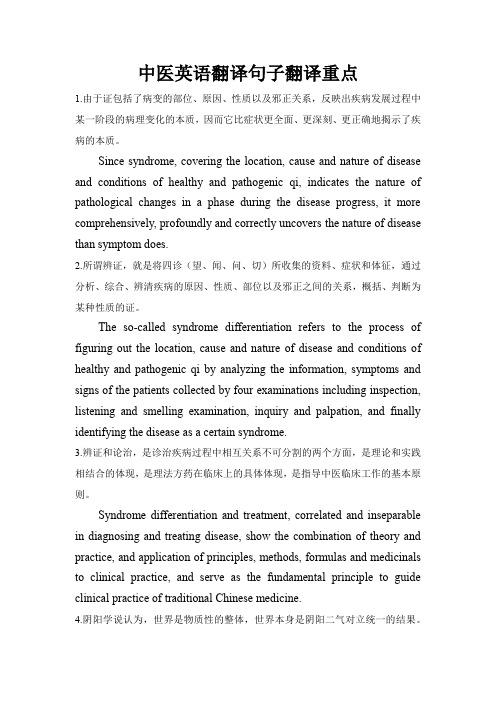
中医英语翻译句子翻译重点1.由于证包括了病变的部位、原因、性质以及邪正关系,反映出疾病发展过程中某一阶段的病理变化的本质,因而它比症状更全面、更深刻、更正确地揭示了疾病的本质。
Since syndrome, covering the location, cause and nature of disease and conditions of healthy and pathogenic qi, indicates the nature of pathological changes in a phase during the disease progress, it more comprehensively, profoundly and correctly uncovers the nature of disease than symptom does.2.所谓辨证,就是将四诊(望、闻、问、切)所收集的资料、症状和体征,通过分析、综合、辨清疾病的原因、性质、部位以及邪正之间的关系,概括、判断为某种性质的证。
The so-called syndrome differentiation refers to the process of figuring out the location, cause and nature of disease and conditions of healthy and pathogenic qi by analyzing the information, symptoms and signs of the patients collected by four examinations including inspection, listening and smelling examination, inquiry and palpation, and finally identifying the disease as a certain syndrome.3.辨证和论治,是诊治疾病过程中相互关系不可分割的两个方面,是理论和实践相结合的体现,是理法方药在临床上的具体体现,是指导中医临床工作的基本原则。
中医英语翻译常用词汇英汉对照
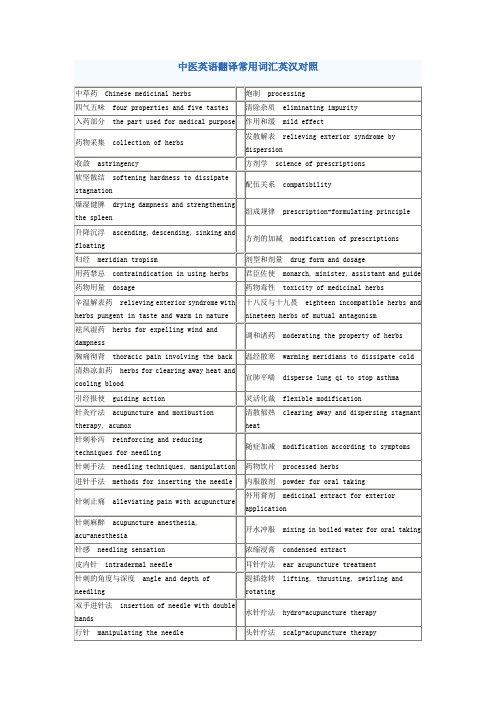
脉象浮紧 floating and tense pulse
手法补泻 reinforcing and reducing manipulations
寒邪束表 pathogenic cold hampering the exterior
拇指平推法 horizontal pushing with the thumb
清热凉血药 herbs for clearing away heat and cooling blood
宣肺平喘 disperse lung qi to stop asthma
引经报使 guiding action
灵活化裁 flexible modification
针灸疗法 acupuncture and moxibustion therapy, acumox
中医英语翻译常用词汇英汉对照
中草药 Chinese medicinal herbs
炮制 processing
四气五味 four properties and five tastes
清除杂质 eliminating impurity
入药部分 the part used for medical purpose
风为百病之长 wind is the leading factor in causing various diseases
水液代谢障碍 disturbance of water metabolism
气随津脱 exhaustion of qi due to loss of body fluid
离经之血 abnormal flow of the blood
津液的形状、功能与分布 form, function, and distribution of the body fluid
中医的专业术语英文翻译(2)
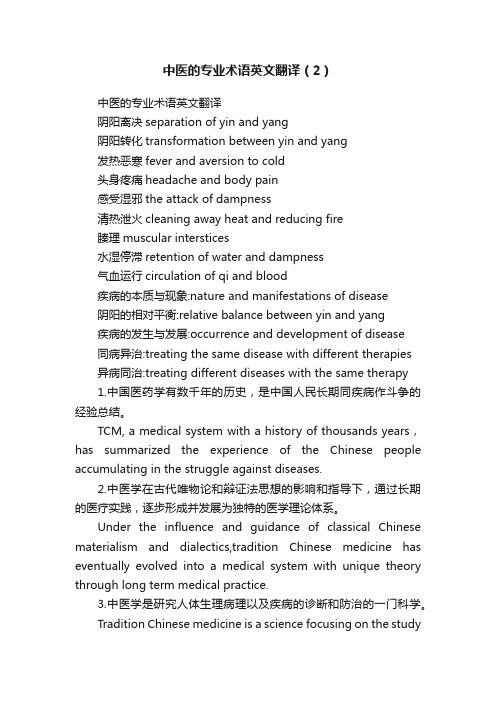
中医的专业术语英文翻译(2)中医的专业术语英文翻译阴阳离决separation of yin and yang阴阳转化transformation between yin and yang发热恶寒fever and aversion to cold头身疼痛headache and body pain感受湿邪the attack of dampness清热泄火cleaning away heat and reducing fire腠理muscular interstices水湿停滞retention of water and dampness气血运行circulation of qi and blood疾病的本质与现象:nature and manifestations of disease阴阳的相对平衡:relative balance between yin and yang疾病的发生与发展:occurrence and development of disease同病异治:treating the same disease with different therapies异病同治:treating different diseases with the same therapy1.中国医药学有数千年的历史,是中国人民长期同疾病作斗争的经验总结。
TCM, a medical system with a history of thousands years,has summarized the experience of the Chinese people accumulating in the struggle against diseases.2.中医学在古代唯物论和辩证法思想的影响和指导下,通过长期的医疗实践,逐步形成并发展为独特的医学理论体系。
Under the influence and guidance of classical Chinese materialism and dialectics,tradition Chinese medicine has eventually evolved into a medical system with unique theory through long term medical practice.3.中医学是研究人体生理病理以及疾病的诊断和防治的一门科学。
中医常用词汇英文翻译01.
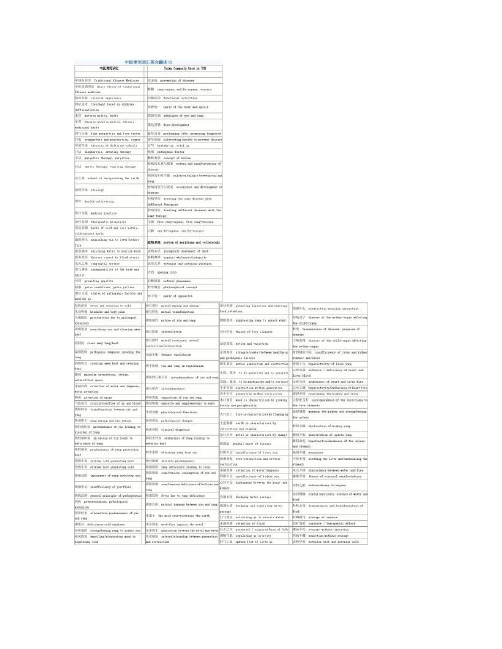
中医英语常用词汇英文翻译02气化不利dysfunction of qi in transformation畏寒喜热aversion to cold and preference for heat 气分热盛excessive heat at qi phase气郁化热stagnation of qi transforming into heat温养脏腑warming and nourishing the viscera瘀血阻络blood stasis obstructing the collaterals清肺润燥clearing the lung and moistening dryness破瘀通经breaking blood stasis to promote menstruation内伤头疼headache due to internal injury祛瘀eliminating stasis, expelling stasis逆传心包reverse transmission into the pericardium气不摄血failure of qi to check the blood宁心安神calming the heart and tranquilizing the mind血液循行circulation of the blood惊悸不安palpitation due to fright气的运动形式the moving styles of qi血液生成不足insufficient production of the blood平肝止血soothing the liver to stop bleeding血液亏虚deficiency of the blood离经之血abnormal flow of the blood津液的形状、功能与分布form, function, and distribution of the body fluid 气血生化之源source for the production and transformation of qi and blood 脉细无力thin and weak pulse肌肤干燥dry skin肌肤甲错squamous and dry skin血脉调和流畅smooth and normal flow of the blood脏腑火热炽盛exuberant fire and heat in the viscera机体正常水液normal fluid inside the body热迫血分heat invading the blood phase气滞津停retention of fluid due to stagnation of qi寒凝气滞stagnation of cold and qi身倦乏力lassitude气滞血瘀qi stagnation and blood stasis伤津脱液consumption and loss of the body fluid津液的营养和滋润作用the nourishing and moistening functions of the body fluid 津液的生成、输布和排泄production, distribution, and excretion of the body fluid 腹痛拒按unpalpable abdominal pain脾的“散精”功能the function of the spleen to “dissipate essence”津液不足insufficiency of the body fluid水液停聚retention of water奇经八脉eight extraordinary vessels, eight extraordinary meridians胃的“游溢精气”the function of the stomach to “distribute essence”津液生化匮乏scanty production of the body fluid津液的代谢平衡the metabolic balance of the body fluid热盛耗伤津液consumption of the body fluid due to excessive heat风为百病之长wind is the leading factor in causing various diseases水液代谢障碍disturbance of water metabolism气随津脱exhaustion of qi due to loss of body fluid水湿困脾dampness encumbering the spleen濡养肌肤moistening and nourishing the skin湿邪内盛exuberance of interior dampness经脉之海sea of meridians脾虚水肿edema due to spleen deficiency滋养脏腑moistening and nourishing the viscera运行全身气血transporting qi and blood in the whole body 十二经别twelve branches of meridians联络脏腑肢节connecting with viscera, limbs and joints 经别divergent meridians 循行路线running route经气meridian qi十二正经twelve regular meridians十二皮部twelve skin areas, twelve skin regions/divisions 经隧阻滞blockage of meridians十二经筋twelve meridian tendons经穴meridian acupoints, Jing-River acupoint饮食劳倦improper diet and overstrain经络辨证syndrome differentiation according to meridians 风寒感冒common cold due to wind-cold经络感传meridian conduction, channel transmission湿热泄泻diarrhea due to damp-heat经络现象meridian phenomena内生五邪five endogenous pathogenic factors经络阻滞blockage of meridians风邪外袭pathogenic wind attacking the superficies舒筋活络relaxing tendons and activating collaterals游走性关节疼痛migratory arthralgias刺血疗法blood-pricking therapy阳气衰退decline of yang-qi外感六淫attacked by six climate pathogenic factors六淫six climatic evils感受寒邪attacked by pathogenic cold经闭发肿amenorrhea with edema虚实夹杂deficiency complicated with excess, asthenia complicated with sthenia 邪正盛衰predominance or decline of pathogenic factors and healthy qi寒性凝滞cold tending to stagnate by nature病症的虚实变化asthenia and sthenia changes of disease腠理闭塞blockage of muscular interstices机体的抗病能力body resistance经脉拘急收引contraction of tendons五心烦热feverish sensation over the five centers湿邪困脾pathogenic dampness encumbering the spleen五心five centers (palms, soles and chest疾病的发生、发展与变化occurrence, development and changes of disease 生津安神promoting the production of body fluid and tranquilizing the mind 体质强弱conditions of constitution蓄血发黄jaundice due to blood accumulation气血功能紊乱dysfunction of qi and blood脾阳不振inactivation of spleen yang阴阳偏盛大relative predominance of yin and yang阴虚生内热yin deficiency generating interior heat五志过极extreme changes of emotions热极生风extreme heat producing wind精气夺则虚depletion of essence causing deficiency七情内伤internal injury due to emotional disorder阴阳互损mutual consumption of yin and yang饮食不节improper diet真热假寒true heat and false cold暴饮暴食craputence气机郁滞不畅stagnation of qi activity神昏谵语coma and delirium津液代谢失常disorder of fluid metabolism四诊合参combined use of the four diagnostic methods寒热往来alternate attacks of chill and fever精神活动mental activities津伤化燥consumption of fluid transforming into dryness 面部表情facial expressions风火胁痛hypochondriac pain due to wind-fire精充气足sufficient essence and abundant qi口眼歪斜wry mouth with distorted eyes, facial distortion 预后良好favorable prognosis湿浊内生endogenous turbid dampness表情淡漠apathetic facial expressions虚火上炎flaming of asthenia-fire精神不振dispiritedness邪气内陷internal invasion of pathogenic factors神志不清unconsciousness大肠热结retention of heat in the large intestine轻宣润燥dispersing lung qi and moistening dryness心脉瘀阻blood stasis in the heart vessels四肢抽搐convulsion of the limbs镜面舌mirror-like tongue脏腑辨证syndrome differentiation of viscera饥不欲食hunger without desire for food病位与病性location and nature of disease脉有胃气pulse with stomach qi表里同病disease involving both the exterior and interior清里泄热clearing away heat in the interior风热眩晕vertigo due to wind-heat寒证化热cold syndrome transforming into heat syndrome寒热错杂simultaneous occurrence of cold and heat舌淡苔白而润滑light-colored tongue with white and slippery coating 表邪入里invasion of the exterior pathogenic factors into the interior 祛风解痉expelling wind to relieve convulsion外感胃脘痛stomachache due to exogenous pathogenic factors医.学全.在.线网站恶寒与恶热aversion to cold and aversion to heat潮热盗汗tidal fever and night sweating口干唇裂dry mouth with cracked lips高热谵妄high fever with delirium脉数无力rapid and weak pulse和血止痛regulating blood to alleviate pain寒邪郁而化热stagnation of pathogenic cold changing into heat寒因寒用treating pseudo-cold syndrome with herbs of cold nature未病先防preventing measures taken before the occurrence of disease热因热用treating pseudo-heat syndrome with herbs of heat nature补气健脾invigorating qi and strengthening the spleen塞因塞用treating obstructive syndrome with tonifying therapy补血养心enriching blood to nourish the heart发汗解表relieving exterior syndrome by diaphoresis水气凌心water attacking the heart风热乳蛾tonsillitis due to wind-heat心悸多梦palpitation and dreaminess痰饮咳嗽cough due to fluid retention血为气母the blood serving as the mother of qi实热蕴结accumulation of sthenia-heat调摄精神regulating mental states舒肝和胃soothing the liver and harmonizing the stomach血脉流畅smooth circulation of blood清热泻火clearing away heat and reducing fire关节通利smooth movement of joints疏风泄热dispelling wind and reducing heat气机调畅free activity of qi行气消瘀activating qi to resolve stagnation益寿延年promoting longevity养血润肠nourishing the blood and moistening the intestine治病求本treatment of disease must concentrate on the principle cause of disease 因时、因地、因人制宜applying proper therapeutic measure in line with season, local conditions and individuality急则治其标relieving the secondary symptoms first in treating acute disease缓则治其本relieving the primary symptoms in treating chronic disease通腑泄热purging fu-organs to eliminate heat燥湿化痰drying dampness and resolving phlegm标本兼治treatment focusing on relieving both the secondary and primary symptoms 正虚邪实asthenia of healthy qi and sthenia of pathogenic factors痰湿壅肺accumulation of phlegm-dampness in the lung血枯经闭amenorrhea due to blood exhaustion祛虫消积removing parasites to eliminate accumulation中医英语翻译常用词汇英汉对照03中草药Chinese medicinal herbs炮制processing四气五味four properties and five tastes清除杂质eliminating impurity入药部分the part used for medical purpose作用和缓mild effect药物采集collection of herbs发散解表relieving exterior syndrome by dispersion收敛astringency方剂学science of prescriptions软坚散结softening hardness to dissipate stagnation配伍关系compatibility燥湿健脾drying dampness and strengthening the spleen组成规律prescription-formulating principle升降沉浮ascending, descending, sinking and floating方剂的加减modification of prescriptions归经meridian tropism剂型和剂量drug form and dosage用药禁忌contraindication in using herbs君臣佐使monarch, minister, assistant and guide药物用量dosage药物毒性toxicity of medicinal herbs辛温解表药relieving exterior syndrome with herbs pungent in taste and warm in nature 十八反与十九畏eighteen incompatible herbs and nineteen herbs of mutual antagonism 袪风湿药herbs for expelling wind and dampness调和诸药moderating the property of herbs胸痛彻背thoracic pain involving the back温经散寒warming meridians to dissipate cold清热凉血药herbs for clearing away heat and cooling blood宣肺平喘disperse lung qi to stop asthma引经报使guiding action灵活化裁flexible modification针灸疗法acupuncture and moxibustion therapy, acumox 清散郁热clearing away and dispersing stagnant heat针刺补泻reinforcing and reducing techniques for needling 随症加减modification according to symptoms针刺手法needling techniques, manipulation药物饮片processed herbs进针手法methods for inserting the needle内服散剂powder for oral taking针刺止痛alleviating pain with acupuncture外用膏剂medicinal extract for exterior application针刺麻醉acupuncture anesthesia, acu-anesthesia开水冲服mixing in boiled water for oral taking针感needling sensation浓缩浸膏condensed extract皮内针intradermal needle耳针疗法ear acupuncture treatment针刺的角度与深度angle and depth of needling提插捻转lifting, thrusting, swirling and rotating双手进针法insertion of needle with double hands水针疗法hydro-acupuncture therapy行针manipulating the needle头针疗法scalp-acupuncture therapy化脓灸blistering moxibustion推拿手法manipulations for tuina, manipulating techniques 瘢痕灸scarring moxibustion减轻疼痛alleviating pain艾炷灸moxibustion with moxa cone功法训练 exercise for practicing tuina 灯火灸 lamp moxibustion 放松肌肉 relaxing muscles 温针灸 warm needling method 解除肌肉紧张 relieving muscular tension 一指禅推法 pushing manipulation with one finger 活动受限 confined activity 点按法 point-pressing manipulation 关节脱位 dislocation of joint 大鱼际揉法 kneading manipulation with the large thenar 腰椎间盘突出 protrusion of lumbar vertebral disc 交替搓揉alternative rubbing and kneading 旋转复位 rotating reduction 腰肌劳损 injury of lumbar muscles 软组织损伤 injury of soft tissues 解除痉挛 relieving spasm 关节粘连僵硬adhesion and stiffness of joint 外感发热 exogenous fever 滑利关节 lubricating joint 脉象浮紧 floating and tense pulse 手法补泻 reinforcing and reducing manipulations 寒邪束表 pathogenic cold hampering the exterior拇指平推法 horizontal pushing with the thumb 邪热入里 interior invasion of pathogenic heat 午后潮热 afternoon tidal fever 四肢厥冷 cold limbs 热扰神明 heat disturbing mind 阳气不振 inactivation of yang-qi 形体消瘦 emaciation 少气懒言 lack of qi and no desire to speak 祛痰止咳药 herbs for eliminating phlegm and stopping cough。
中医常用术语英文翻译
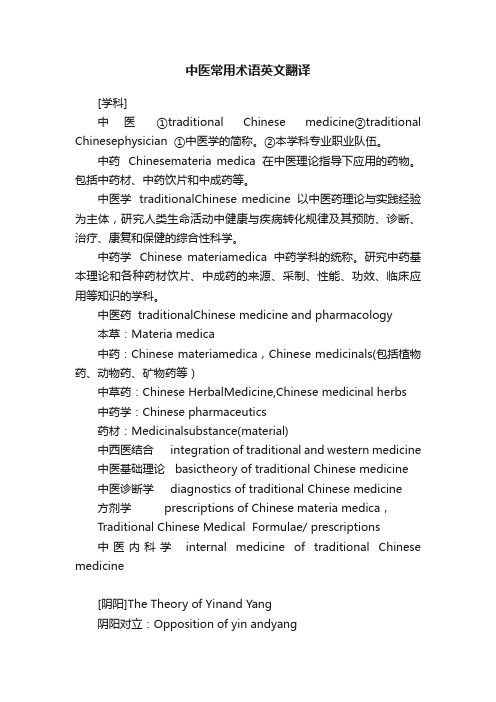
中医常用术语英文翻译[学科]中医①traditional Chinese medicine②traditional Chinesephysician ①中医学的简称。
②本学科专业职业队伍。
中药Chinesemateria medica 在中医理论指导下应用的药物。
包括中药材、中药饮片和中成药等。
中医学 traditionalChinese medicine 以中医药理论与实践经验为主体,研究人类生命活动中健康与疾病转化规律及其预防、诊断、治疗、康复和保健的综合性科学。
中药学Chinese materiamedica 中药学科的统称。
研究中药基本理论和各种药材饮片、中成药的来源、采制、性能、功效、临床应用等知识的学科。
中医药 traditionalChinese medicine and pharmacology本草:Materia medica中药:Chinese materiamedica,Chinese medicinals(包括植物药、动物药、矿物药等)中草药:Chinese HerbalMedicine,Chinese medicinal herbs中药学:Chinese pharmaceutics药材:Medicinalsubstance(material)中西医结合 integration of traditional and western medicine 中医基础理论 basictheory of traditional Chinese medicine 中医诊断学 diagnostics of traditional Chinese medicine 方剂学 prescriptions of Chinese materia medica,Traditional Chinese Medical Formulae/ prescriptions中医内科学 internal medicine of traditional Chinese medicine[阴阳]The Theory of Yinand Yang阴阳对立:Opposition of yin andyang阴阳制约:Restriction of/between yin and yang阴阳互根:Interdependence ofyin and yang阴阳消长:Waxing and waning ofyin and yang阴阳转化:Inter-transformationof yin and yang[五行学说]The Theory of FiveElements五行:water,fire,wood,metal,soil生:promote, generate,engender克: act, restrict,restrain乘:overact,over-restrict, over-restrain, subjugate, overwhelm侮:counteract,counter-restrict, counter-restrain, rebel[整体观念] concept of organicwholeness辩证法 dialectics生长化收藏 sprouting, growth,transformation,ripening,storage内外环境统一性 the unity betweenthe internal and external environments机体自身整体性 the integrity of thebody itself古代唯物论和辩证法 classic Chinesematerialism and dialectics 矛盾统一the contradictoryunity互相联系、相互影响related to each otherand influence each other标本 Biao (secondaryaspect) and Ben (primary aspect)本质与现象nature and phenomena矛盾的普遍性和特殊性universality andspeciality of contradictions寒者热之Cold disease shouldbe treated by warm therapy热者寒之warm disease shouldbe treated by cold therapy虚者补之deficiency syndromeshould be treated by tonifyingtherapy实者泻之excess syndromeshould be treated by purgation therapy治病必求其本 Treatment ofdiseases must concentrate on the root cause同病异治treatment ofthe same disease with different therapeutic methods异病同治treatment ofdifferent diseases with the same therapeutic method[精气神]清阳为天 The lucid Yangascends to form the heaven浊阴为地 The turbid Yindescends to constitute the earth气化 Qitransformation升降出入 ascending,descending, going out, coming in出入废则神机化灭,升降息则气立孤危。
中医英语课后句子翻译1(含中文 lesson1-10)
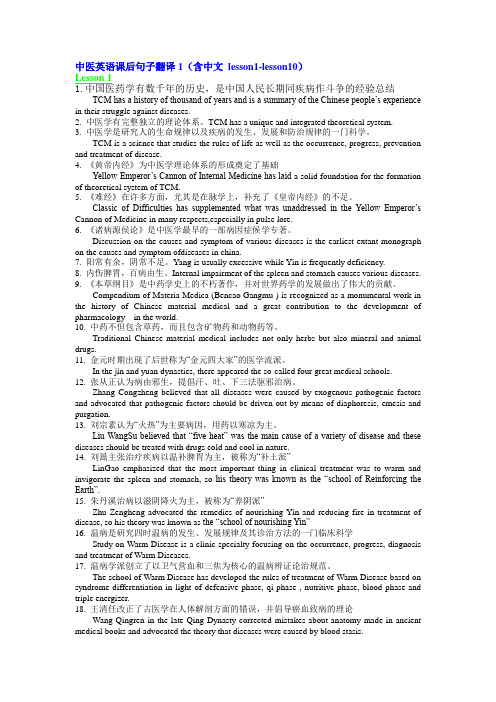
中医英语课后句子翻译1(含中文lesson1-lesson10)Lesson 11.中国医药学有数千年的历史,是中国人民长期同疾病作斗争的经验总结TCM has a history of thousand of years and is a summary of the Chinese people’s experience in their struggle against diseases.2. 中医学有完整独立的理论体系。
TCM has a unique and integrated theoretical system.3. 中医学是研究人的生命规律以及疾病的发生、发展和防治规律的一门科学。
TCM is a science that studies the rules of life as well as the occurrence, progress, prevention and treatment of disease.4. 《黄帝内经》为中医学理论体系的形成奠定了基础Yellow Emperor’s Cannon of Internal Medicine has laid a solid foundation for the formation of theoretical system of TCM.5. 《难经》在许多方面,尤其是在脉学上,补充了《皇帝内经》的不足。
Classic of Difficulties has supplemented what was unaddressed in the Yellow Emperor’s Cannon of Medicine in many respects,especially in pulse lore.6. 《诸病源侯论》是中医学最早的一部病因症候学专著。
Discussion on the causes and symptom of various diseases is the earliest extant monograph on the causes and symptom ofdiseases in china.7. 阳常有余,阴常不足。
中医英语术语翻译重点

中医英语术语翻译重点天人相应Correspondence of human body and natural environment 辨证论治treatment based onsyndrome differentiation针灸acupuncture and moxibustion寒凉药物herbs cold and cool in nature滋阴降火nourishing yin and reducing fire整体观念concept of holism开窍(of the five zang-organs) open into生长化收藏sprout, grow, transform, ripen and store同病异治different therapeutic methods used to treat the same disease异病同治same therapeutic method used to treating different diseases从阴引阳drawing yang from yin阴平阳秘balance of yin and yang寒极生热extreme cold generating heat热极生寒 extreme heat gernerating cold病机总纲general rule of pathogenesis祛风散寒eliminating wind and dispersing cold实则泻之treating excess syndromes with reduction虚寒证deficiency cold syndrome实热症 excess heat syndrome潜阳熄风suppressing yang and eliminating wind补其不足 supplement insufficiency泻其有余 reduce excess五行学说the theory of five elements木曰曲直wood characterized by bending and straightening 火曰炎上fire characterized by flaring up土爰稼穑earth characterized by sowing and reaping金曰从革metal characterized by clearing and changing水曰润下water characterized by moistening and descending 母病及子illness of mother viscera affecting the child one 子病及母illness of child viscera affecting the mother one 相乘相侮over restriction and counter-restriction心火亢盛exuberant fire in the heart肾阳式 of kidney yang平肝和胃soothing the liver and harmonizing the stomach水火不济between water and fire奇恒之腑extraordinary fu-organs藏象学说the theory of visceral manifestation藏而不泻storage without discharge泻而不藏discharge without storage形体诸窍physical build and various orifices其华在面the luster manifesting upon the face满而不实 full but not to be solid实而不满solid but not to be full心主血脉heart governing blood and vessels肺司呼吸lung controlling breathing脾主运化spleen governing transportation and transformation 肝主疏泄liver controlling conveyance and dispersion肾主藏精kidney governing storing essence面色无华lusterless complexion汗血同源sweat and blood sharing the same origin升降出入ascending, descending, going out and going in宣发肃降dispersion, purification and descent后天之本acquired base of life肝气逆上upward adverse flow of liver qi先天之精innate essence奇恒之腑extraordinary fu-organs孤俯isolated fu-organ腐熟水谷digest water and food七冲门the seven important portals胆主决断The gallbladder is responsible for making judgment 泌别清浊separating the lucid from the turbid大肠主津The large intestine governs thin body fluid小肠主液The small intestine governs thick body fluid先天禀赋innateness温养腑脏warming and nourishing the viscera津血同源body fluid and blood sharing the same origin气为血帅,血为气母Qi commands the blood and the blood carries qi.益气固脱nourishing qi to stop collapse奇经八脉eight extraordinary vessels十二经筋tendons of the twelve regular meridians舒经活络soothing meridians and activating collaterals刺络拔罐collateral pricking and cupping therapy腠理闭塞stagnation of interstitial space湿邪困脾pathogenic dampness obstructing the spleen外感六淫six excesses pathogenic factors饮食劳倦mproper diet and overstrain阳常有余,阴常不足Yang is usually excessive while yin is frequently deficient.四大经典Four GreatClassic:Huangdi s Canon of Medicine黄帝内经Classic of Difficulties难经Shennong s Classic of Materia Medica神农本草经Rreatise on Cold Damage and Miscellaneous Diseases伤寒杂病论四气four properties:cold,,hot,warm,cool五味five flavors:sour,bitter,sweet,pungent,salty(中药)七情seven conditions of ingredients in prescriptions Single effect,mutual reinforcement,mutual assistance,mutual restraint,mutual inhibition,mutual antagonism,mutual suppression寒凉派Liu Wansu-School of Cold and Cool攻下派Zhang Congzheng-School of Purgation补土派Li Gao-School of Reinforcing the Earth滋阴派Zhu Zhenheng-School of Nourishing Yin辛温中药herbs pungent in taste and warm in nature辛凉中药herbs pungent in taste and cool in narure向日为阳,背日为阴The side facing the sun belongs to yang and the reverse side to yin,血液常行的前提条件:心气充沛,血液充盈,脉道通利Normal circulation of blood:abundance of heart qi,sufficiency of blood,vessels are prerequisite.四气;元气primordial qi,宗气pectoral qi,营气nutrient qi,卫气defensive qi内生五邪;内风,内寒,内湿,内燥,内火Five internal excesses;internal cold,internaldampness,inrenal dryness,internal fire内伤七情Internal injury due to sevenemotions;joy,anger,anxiety,thought,sorrow,fear,fright怒则气上,喜则气缓,悲则气消,恐则气下,惊则气乱。
中医术语中英文版
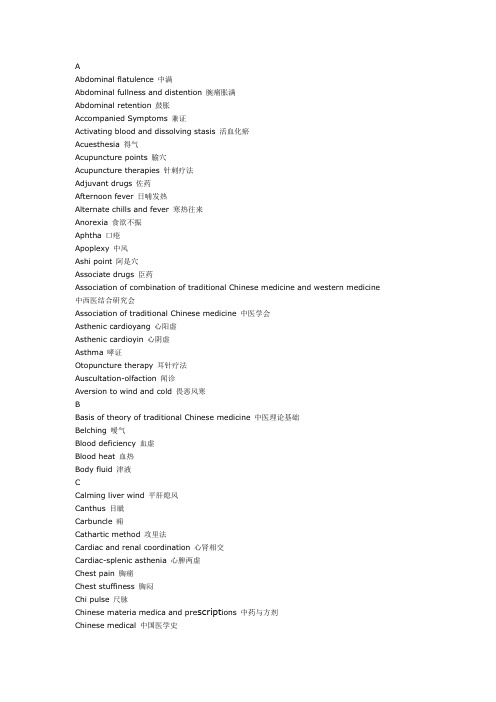
AAbdominal flatulence 中满Abdominal fullness and distention 腕痛胀满Abdominal retention 鼓胀Accompanied Symptoms 兼证Activating blood and dissolving stasis 活血化瘀Acuesthesia 得气Acupuncture points 腧穴Acupuncture therapies 针刺疗法Adjuvant drugs 佐药Afternoon fever 日哺发热Alternate chills and fever 寒热往来Anorexia 食欲不振Aphtha 口疮Apoplexy 中风Ashi point 阿是穴Associate drugs 臣药Association of combination of traditional Chinese medicine and western medicine 中西医结合研究会Association of traditional Chinese medicine 中医学会Asthenic cardioyang 心阳虚Asthenic cardioyin 心阴虚Asthma 哮证Otopuncture therapy 耳针疗法Auscultation-olfaction 闻诊Aversion to wind and cold 畏恶风寒BBasis of theory of traditional Chinese medicine 中医理论基础Belching 嗳气Blood deficiency 血虚Blood heat 血热Body fluid 津液CCalming liver wind 平肝熄风Canthus 目眦Carbuncle 痈Cathartic method 攻里法Cardiac and renal coordination 心肾相交Cardiac-splenic asthenia 心脾两虚Chest pain 胸痛Chest stuffiness 胸闷Chi pulse 尺脉Chinese materia medica and pre script ions 中药与方剂Chinese medical 中国医学史Chinese medicine anesthesia 中药麻醉Chinese patent drugs 中成药Clear abundant urine 小便清长Clearing damp 利水渗湿Clearing heat and expectoration 清热化痰Clearing wind-damp 祛风胜湿Clearing Ying heat and cooling blood 清营凉血Coating color 苔色Cold hands and feet 手足厥冷Cold-heat mixing 寒热交错Cold limbs 手足厥冷Cold stroke 中寒Coma 神昏Compendium of Materia Medica 本草纲目Complications 并病Constipation 大便不通Consumptive disease 虚劳Contrary treatment 反治DDefensive Qi instability 卫气不固Deficiency-excess mixing 虚实夹杂Delirium 谵语Diagnostic methods of traditional Chinese medicine 中医诊法Diaphoresis 汗法Diaphoresis, pungent cold 辛凉解表Diaphoresis, pungent warm 辛温解表Diarrhea 泄泻Different treatments for the same disease 同病异治Differentiation, eight principles 八纲辨证Differentiation of diseases 辨病Differentiation of symptoms and signs 辨证Differentiation, six meridians 六经辨证Differentiation, triple energizer 三焦辨证Differentiation, Wei-Qi-Ying-Xue 卫气营血辨证Differentiation, Zang-Fu 脏腑辨证Diphtheria 白喉Diseases of Qi-blood-fluid 气血津液病症Dispersing cold and freeing Bi 散寒通痹Doctrines of various historical schools 中医各家学说Dry heat 燥热Dry stool 大便干结Dysentery 痢疾Dyspepsia 食滞Dysphagia 噎膈Dyspnea 喘证Dysuria 癃闭EEdema 水肿Eight principles 八纲Electuary 冲服剂Elimination 消法Emesis 吐法Endogenous hygrosyndrome 内湿Endogenous cold 内寒Endogenous dryness 内燥Epilepsy 痫证Epitaxis 鼻衄Eruption 斑疹Etiology 病因Exterior syndrome 表证Exterior sthenia 表实Exterior asthenia 表虚Extremely cold limbs 手足厥逆FFacial distortion 口眼歪斜Feeling 按诊Fluid deficiency 津液不足Frequent micturition 小便频数Frequent vomiting 反胃GGastric asthenia 胃虚Gastric cavity 胃脘Gastro-Qi 胃气Generation-inhibition in five elements 五行相克Gingiva 牙龈Greyish fur 灰苔HHarmonizing liver-spleen 调和肝脾Heart fire hyperactivity 心火亢盛Heart-kidney Yang deficiency 心肾阳虚Heart Yang hypoactivity 心阳不振Healthy Qi 正气Hectic fever 潮热Hemorrhage Zheng 血证IInsomnia 失眠Inspection 望诊Intergeneration 相生Inter-restriction 相克Inter-subjuation 相乘Irregular pulse 结代脉KKidney Yang deficiency 肾阳虚Kidney Yin deficiency 肾阴虚LLarge intestine damp-heat 大肠湿热Large pulse 大脉Leukorrhea 白带Liver fire flaming 肝火上炎Liver-stomach disharmony 肝胃不和Liver wind agitation 肝风内动Liver Yang rising 肝阳上亢Liver Yin deficiency 肝阴虚Long pulse 长脉Longer menstrual interval 月经后期Loose stool 便溏Lung heart 肺热Lung Qi deficiency 肺气虚Lung Qi impairment 肺气失宣MMeasles 麻疹Menstrual irregularities 月经失调Merdian-collateral theory 经络学说Meridial distribution 归经Mutual promotion 相须NNight sweat 盗汗Nine orifices 九窍Normal pulse 平脉Nourishing blood and liver 养血柔肝PPale tongue 淡白舌Palpation 切诊Palpitation 心悸Pathogenesis 病机Peeled coating 剥脱苔Pestilence 疫疠Pharynx neurosis 梅核气Phlegm-damp obstructing lung 痰湿阻肺Pill 丸Pores 玄府Principal and subordinate 标本Pulse condition 脉象Pulse-taking 脉诊Purgation-tonifying 攻补兼施QQi-blood and fluid 气血津液Qi deficiency 气虚Qi depression 气滞Qi function 气机RRapid pulse 数脉Relaxing bowels 润肠通便Removing stasis to promote blood circulation 化瘀行血Resolving damp, aromatic 芳香化湿Resuscitation 开窍Retch 干呕Reverse restriction 相侮SSchool in favour of the doctrine of warm diseases 温病学派School of febrile diseases by cold injury 伤寒学派Scrofula 瘰疬Sighing 太息Smallpox 天花Somnolence 多寐Sore 疮Spleen Qi deficiency 脾气虚Spleen Yang deficiency 脾阳虚Spleen Yin deficiency 脾阴虚Spontaneous sweating 自汗Stranguria 小便涩痛Stomach cold 胃寒Stomach heat 胃热Strengthening healthy energy 扶正Striae 腠理Stringy pulse 弦脉Sunstroke 中暑TTenesmus 里急后重Tonifying deficiency 虚则补之Tonifying kidney and holding Qi 补肾纳气Tonifying Qi and spleen 益气健脾Treating excess with purgation 实则泻之Treatment with syndrome differentiation 辨证论治Twenty-eight pulses 二十八脉UUlcer 溃疡Urinal incontinence 小便失禁Uterus 女子胞VVitaport 命门WWhitish fur 白苔Whooping cough 百日咳YYellowish fur 黄苔Ying and Yang in balance 阴平阳秘ZZheng 证一阳"frist yang, Shaoyang Channel"一阴"frist yin, Jreyin Channel"一逆one mista ade in treatment一息respiration一侧的unilateral一日量daily dose一服药a dose of medicine一夫法finger breadth measurement一身痛重general pain and heaviness乙癸同源Yi(the live) and Gui)the Kidney) bejing the same source二阴"two lower orifices, ie, the external urethral orifice and the anus" 二浊reddish and whitish turbid urine二十八脉twenty-eight kinds of pulse condition二阳并病Shaoyang syndrome complicated by T aiyang syndrome二便不利difficulty in urination and defecation二便失禁urinary and fecal incontinence十问inquire about ten aspects of the patient十剂ten kinds of pre script ion十八反eighteen incompatible medicaments十二剂twelve kinds of pre script ion十二节twelve joints十二禁twelve contraindications十二经twelve regular channels十二时traditional twelve two-hour periods十二脏twelve internal organs十二怪脉"ten moribund pulses, ten kinds of paradoxical pulse condition" 十九畏nineteen nedicaments of nutual antagonism十三科the thirteen medical specialties十四经the fourteen channels十五络(脉)fifteen main collaterals十二节刺twelve methods of needling十二经别branches of the twelve regular channels十二经筋muscle along the twelve regular channels十二皮部twelve skin areas十六郄穴sixteen cleft points十四经穴"accupuncture points on the fourteen regular channels, acupoints on regular channels"十五络穴fifteen main collaterals points十二经动脉arteries of the twelve channels十二井穴twelve well-points十二经之海sea of the twelve channels丁痂scar丁奚疳infantile malnutrition due to excessive feeding丁躬势bowing丁字形骨折T-shaped fracturre七方"seven pre script ions, Seven formulae"七恶the symtoms and signs indicating poor prognosis of suppurative infections of the exterior part of the body七窍seven orifices七情seven emotions七疝seven kinds of hernia七伤 1.seven kinds of impairments 2.seven symptoms suggesting consumption of the kidney-qi七冲门seven important portals七怪脉"seven moribund pulses, seven paradoxical pulse conditions, seven fatal pulse conditions"七日风=脐风neonatal tetanus七星针=梅芬针seven star needle八纲the eight principal syndromes serving as guidelines in diagnosis八法eight therapeutic methods八廓the eight regions of the white of the eye八溪eight joints八会穴"eight hui-points, eight influential points"八片锦different pictures of superficial venules of index finger in children as a reference for diagnosis八纲辨证analyzing and differentiating pathological conditions in accordance with the eight principal syndromes八脉交会穴eight confluence points人中疔boi on philtrum人咬伤human bite; bite by man人迎脉Renying pulse人背复位back-carrying reduction人痘接种human variolation人工牛黄"artificial ox gallstone, Calculus Bovis Factitius"人事不省=神昏unconsciousness入臼joint reduction儿风eclampsia儿病=恶阻儿茶"catechu, blzck catechu, Catechu"儿枕痛after-pains儿捧母心breech presentation儿科四大要证four chief diseases in pediatrics九刺nine types of needling九气nine kinds of illness due to disturbance of qi九窍nine orifices九脏nine internal organs九虫病parasitic diseases九窍出血bleeding from the nine orifices九六补泻法nini-six reinforcing-reducing method刀伤incised wound刀晕traumatic syncope刀创伤drug for incised wound刀斧伤wound by knife or ax三宝"three exxentialsessence, qi and configurative force"三痹three types of arthralgiz三刺=齐刺three-stratum puncture三法"three therapeutic methods-diaphoresis, emesis, and purgation" 三伏"1.three periods of dog days, 2.the third period of dog days"三关the three passes三焦"tri-jiao, sanjiao, triple warmer, triple heater"三毛(丛,聚)clump hair三品three grades of medicines三消three types of diabetes三因three categories etiologic factors三虫病three intestinal parasitoses三春柳=柽柳三焦病disease of tri-jiao三焦经Tri-jiao Channel三焦咳tri-jiao cough三棱针"three-deged needle, tri-ensiform needle"三陷证three typesof inward penetration of pyogenic agent三阳病disease of the three yang channels三阳经three yang channels三阳络Sanyanglo三阴病diseases of the three yin channels三阴经three yin channels三阴痉convulsion with symptoms of three yin channels三阴疟three-yin malaria三板疗法"tri-tabular massage, massage with three Kinds of boards"三部九候three portions and nine pulse-takings7 三焦辨证differentiation of syndrome according to the pathological changes of trijiao 三焦实热heat in tri-jiao of excess type三焦虚寒cold syndromes of deficiency type三阳合病disease involving all three yang channels三点挤压法three-point pressure method三焦主决渎the triple warmer manages the dredging of water pathway干便dry stool干疽cellulitis at the anterolateral aspect of the shoulder干咳"dry cough, unproductive cough"干呕retching干陷dry type of inward penetation of pyogenic agent干癣1.chronic eczema 2.neurodermatitis干皮dried bark干血劳emaciation due to blood disorders干胁痛dry hypochondriac pain干脚气dry beriberi干霍乱dr cholera干眼症xerophthalmia干拔罐1.dry cupping 2.ordinary cupping土earth(in five elements)土方"folk recipe, local recipe"土疳=针眼hordeolum土栗infection of the heel土风疮popular urticaria土生甘sweet flavour is attributed to earth土生金earth generates metal土克水earth restricts water土脯子mantis cheeks土乘水earth subjugates water土不制水earth fails to control water土生万物earth produces myriads of things土喜温燥earth prefers warmth and dryness土郁夺之Dampness accumulated in the spleen(earth) should be removed8 下胞Lower eyelid下膊forearm下法"purgation, purgative therapy"下疳chancre下膈intake of food in the morning and vomiting in the evening下工"an inferior medical worker, an inexperienced healer"下骨sending down the fishbone下极1.anus 2.perineum 3.area between inner canthi 4.another name for Hengku下焦"lower-jiao, lower warmer, lower heater, lower burner"下利diarrgea下迫tenesmus下气"1.a therapeutic mithod to keep the adverse qi flowing downward 2.aerofluxus, breaking wind 3.qu of the lower part of the body"下窍lower orifices下泉urine下乳=催乳lactogenesis下脘1.phlorus 2.Hsiawan下陷=中气下陷descending disorders下消"diabetes of the kindney type, diabetes incolving the lower-jiao"下搭手lower back cellulitis下丹田lower elixir field下发背"lumbar carbuncle, deep-rooted ulcer in the lumbar region"下焦病lower-jiao syndrome下马痈acute pyogenic infection of right下石疽indurated mass of knee下牙床mandible下注疮eczema of shank下病上取treating diseases of the lower part of the body by needling points on the upper part of the body下腹胀气flatulence in the lower abdomen下汲肾阴consumption of the kidney-yin by the excessive heart fire下焦如渎lower-jiao resembling water passages下焦主出The Lower-jiao is in charge of excretory system下厥上竭exharstion of blood with cold limbs下厥上冒dizzeness caused by adverse flow of qi下利清谷diarrhea with undigested food in the stool下损及上dusease in the lower part affecting the upper下胎毒法dispelling toxic heat and meconium gathered at the fetus for the new born下者举之Sinking disorders should be treated with drugs of raising property; prolapse and ptosis must be treated with the lifting method to reinforce the vital function of the spleen 下焦湿热downward flow of damp and heat下利赤白dysenteric diarrhea下横骨伤fracture of public bone下行通路descending pathway 最新回复zzzxxx001 at 2007-7-06 22:45:43大夫"an official's title in the feudal age, now used for a doctor in northern China"大肠large intestine大毒extremely poisonous drugs大方heavy pre script ion大分distinct line between large muscles大风= 麻风大腹upper abdomen大谷large space between muscles大汗"profuse sweating, byperhidrosis, excessive perspiration"大经rge channels 2.the needling of points on a large channel exhibiting symptoms 大厥coma大络large collatereals大脉"large pluse, gigantic pulse"10 大衄profuse bleeding from the mouth and nose大气"atmosphere, air"大溲(解)"defecation, bowel movements"大泻vigorous reduction大医respected doctor大针large needle大眦=内眦great canthus大节large joints大产eutocia大便feces; stool;defecation大耳mycrotia大肉large muscles大嘴macrostomia大肠病disease of large intestine大肠经"Large Intestine Channel, LI"大肠虚asthenia of large intestine大肠痈acute appendictis大肠胀flatulence of large intestine大方科speciality of internal medicine大瘕泄dysentery大结胸large accumulation of phlegm-heat in the chest大头垫megacaput pad大头风=大头瘟infection with swollen head大腿疽=股疽大腿痈carbuncle of thigh大泻刺drainage needling大指间web of great toe大周天large cirde of vital energy大眦漏=漏睛dacryocystitis大方脉adult's pulse大出血"massive hemorrhage,hematorrhea"大肠气inguinal hernia大麻风"lepra, leprosy"大便溏loose stool大补元气invigorating primodial qi大肠寒结constipation due to retention of cold-pathogen in large intestine大肠滑脱prolapse of rectum大肠气滞qi stagnation of large intestine大肠热结large intestinal11 大肠湿热large intestinal damp-heat大肠虚寒asthenia-cold of large intestine大肠液亏deficiency of fluid in large intestine大方脉科internal medicine大风恶疫=麻风大肉陷下obvious emaciation and muscular atrophy大头伤寒=大头瘟大眦脓漏dacryocystitis with pyorrhea大气疗法aerotherapy大风荷毒most dangerous pathogenic factors大肠津亏fluid deficiency in the large intestine大便干结dry stool大便不通constipation大便色黑"black stool, melena"大便如漆tarry stools大便失禁incontinence of feces大便困难dyschesia大便频数frequency of bowel movement大汗淋漓profuse perspiration大骨枯槁bones become dry and brittle大渴引饮extreme thirst大肠主传导large intestine takes charge of transportation大实有羸状appearance of deficiency in extreme excess兀兀欲吐intense nausea万灵药panacea寸a length measurement corresponding to the middle segment of one's middle finger 寸脉cun pulse寸口脉cunkou pulse寸白虫proglottid of tapeworm寸白虫病taeniasis寸、关、尺"cun,guan,and chi,inch,bar,and cubit"上胞upper eye lid上膊upper arm上膈"postcibal vomiting,vomiting immediately after in gestion"12 上工"Shang-gong,superior medical worker"上火sufering from excessive internal heat上焦"upper-jiao,upper warmer,upper heater"上气1.abnormal rising of qi 2.the upper qi上窍upper orifices上脘1.shangwan 2.episgastrium上消diabetes involving the upper-jiao上搭手cellulitis near the scapular region上丹田upper elixir field上腭痈abscess on palate上耳背Shangerpei上发背suppurative inflammation of the uppermost part of the back上横骨sternal notch上马痈left buttock carbuncle上石疽upper stony mass behind the ear上水鱼abscess of the popliteal region上牙床upper dental bed上肢瘫paralysis of upper extremities上焦证upper warmer syndrome上胞下垂"ptosis,blepharoptosis"上病下取treating diseases in the upper part by managing the lower上膈下膈upper stenosis and lower stenosis上寒下热cold in the upper and heat in the lower上焦病症syndrome of the upper-jiao上焦如雾the upper-jiao resembling a sprayer上焦主纳The upper-jiao is in charge of receiving上骱手法reduction of dislocation上厥下竭syncope due to exhaustion below上气喘促shortness of breath上热下寒heat in the upper and cold in the lower上实下虚excess in the upper and deficiency in the lower上损及下the upper effecting the lower上吐下泻vomiting and diarrhea上下配穴"coordination of the acupionts of the upper with those of the lower, superior-inferior point association"上虚下实deficiency in the upper and excess in the lower上肢不遂moter impairment of the upper extremities上翘下钩势dorso-extension and ventro-flexion exercise口"mouth,oral cavity"口臭"foul breath, halitosis"口疮"aphthae,canker sore"口淡tastelessness口服"per oral,per os"口疳aphthae in children口紧=唇紧口噤"lockjaw, trismus"口苦bitter taste口软flaccidity of mouth in infants口水"saliva,spittle"口酸sour taste口{口呙} wry mouth口咸salty taste口吃"stutter,stammer"口糜erosion of mucous membrance of the oral carity口渴thirst口不仁numbness of mouth口齿科specialty of stomatology and dentistry口甘甜sweet taste口疳风=舌头泡blisters of the tongue口丫疮"ulcer on the angle of lips,perleche"口中和normal sense of mouth口臭口烂halitosis and aphthosis口唇发紫cyanotic lips口唇紧缩=唇紧口干唇裂dry mouth with cracked lips口噤唇青trismus with cyanotic lips口舌糜烂aphthous stomatitis14 口涎外溢"1.involuntary drooling 2.sialorrhea,ptyalism,sialism,excessive flow of saliva" 口眼{口呙}斜"1.facia hemiparalysis deviation of the eye and mouth, wry mouth with distorted eyes"口中无味=口淡flat feeling in mouth口干唇燥dry mouth and lips口不知谷味loss of appetite口齿咽喉科"1.Department of the Mouth, Teath and Throat 2.specialty of mouth tooth-throat" 口沃沫多唾excessive salivation with froth千日疮verruca vulgaris千岁疮=流注疮widespread scrofula久咳chronic cough久痢protracted drsentery久疟chronic malaria久痔=肛漏recto-analfistula久泻chronic diarrhea久热伤阴persistent fever injuring yin essence久不受孕fail to be impregnated for a long time久泻不止chromic diarrhea丸剂"pill,bolus"广肠sigmoidorectum广疮=杨梅疮syphilis广明anterosuperior part of the human body丫叉毒丫刺毒pustule in the web between the fiest and second metacarpals亡血"hemorrhage, bleading"亡阳"yang depletion,yang exhaustion"亡阴"yin depletion,yin exhaustion"亡血家patient with hemorrhagic diathesis尸厥corpse-like syncope尸体"corpse,cadaver"尸咽"ophthalmo-oro-genital syndrome,Behcet's syndrome"卫defensive function卫气defensive energy卫分证" weifen syndrome,febrile disease at wei phase,syndrom of wei system"卫生局"health bureau, sanitary bureau"卫生学sanitary science卫气不固=表气不固wei-energy fail to protect the body卫气同病"syndrome of both weifen and qufen,syndrome of both qi and wei systems"卫气管血辨证analysing and differentiating the development of an epidemic febrile disease by studying condition of the four systems女科"1.women's diseases,gynecology and obster\trics 2.medical department for women,department of gyhecology and obstetrics"女医1.woman physician 2.physician who attends to women's diseases女劳疸jaundice due to sexual intemperance女劳复relapse of disease due to intemperance in sexual life女子胞uterus女阴溃疡ulcerative vulvitiszzzxxx001 at 2007-7-06 22:46:39小产"abortion, miscarriage"小肠the small intestine小毒"d toxicity 2.drugs with a little toxicity,slightly poisonous drugs"小方"minor pre script ion,minor or mild pre script ion"小分small space between muscles小腹=少腹lower abdomen小逆minor mistake in treatment小溲urine小溪=溪谷小心=心包络=命门小眦"lateral canthus, external canthus"小耳microtia小眼microphthalmus小嘴microstomia小便"urine, urination, micturition"小肠病disorder of the small intestine16 小肠经=手太阳小肠经small intestine channel小肠咳"small intestine cough, cough accompanied by flatulence"小肠疝[气] hernia小肠痈small intestinal abscess小肠胀flatulence of the small intestine小方科specialty of pediatrics小腹满distension of lower addomen小夹板splintlet小结胸accumulation of phligm-heat in the chest小伤寒"common cold, common cold of wink-cold type"小舌头uvula小腿疽=胫疽leg cellulitis小中风faint小周天a small circle of the evolutive小眦漏fistula in the lateral canthus小方脉infantile pulse小腹疽(痈)carbuncle of lower abdomen小便短赤scanty dark urine小便短小oliguria小便黄赤dark urine小便辣痛ardor urine小便淋沥dribbling urination小便涩痛difficulty and pain in micturition小便灼热burning sensation during urination小肠实热excessive heat in the small intestine小肠虚寒hypofunction of the small intestine with cold manifestations小儿暴惊sudden fright in children小儿表热exterior-heat syndrome in children小儿虫吐parasite vomiting in children小儿喘急dyspnea in children小儿卒利acute infantile diarrhea in children17 小儿扎目incessant winking of eyes in children小儿发热fever in children小儿发痧eruptive disease in children小儿疳眼eye disorder due to malnutrition in children小儿寒吐vomiting in children due to cold小儿脚拳1.infantile pedal spasm 2.spasm of toes in children小儿惊吐vomiting in children induced by frightening小儿咳逆choking cough in children小儿客忤convulsive seizure in duced by terror in children小儿羸瘦emaciation in children小儿里热endopathic heat syndrowme in children小儿脉法pulse-taking in children小儿热吐vomiting in children due to heat小儿实热heat syndrome of excess type in children小儿食积infantile indigestion with food retention小儿手拳contracture of fingers in children小儿瘫痪infantile paralysis小儿痰鸣wheezing cough in children小儿通睛"esotropia in children, convergent strabismus in children"小儿吐泻vomiting and diarrhea in children小儿哮喘asthma in children小儿虚热heat syndrome of deficiency type in children小儿遗溺(尿)"1.incontinence of urine in children 2.bed-wetting, nocturnal enuresis in children"小儿脉科specialty of pediatrics小户嫁痛pain in vagina小溲热赤dark urine with burning sensation小腿转筋spasm of calf小儿夜啼nocturnal fretfulness infinfants小儿疳积mallnutrition and indigestion syndrome in children18 小儿浮肿edema in children小儿痢疾dysentery in children小儿感冒common cold in children小儿痢证epilepsy in children小儿淋证infection of urinary system in children小儿风水acute glomerular小儿血虚anemia in children小儿自汗"spontaneous perspiration in children, hyperhidrosis in children"小儿咳嗽cough in children小儿腹痛abdominal pain in children小儿无耳anotia小便不利"dysuria, difficulty in micturition"小便不禁=小便失禁"incontinence of urine, aconuresis"小便淋沥dripping discharge of urine小便频数frequency of micturition小儿暑热(渴)证summer fever of children小儿痰湿吐"vomiting in children, due to phlegmdampness"小肠主受盛small intestion has a function of reception小腹中痞块mass in the lower abdomen小儿涕液不收incessant running nose in children小儿推拿疗法infantile massage小儿囟门不合non-closure of fontanels in infants小儿时行痿poliomyelitis小儿遗毒烂斑congenital syphilis飞痘pustules from smallpox vaccination飞法flying method飞疡(扬)喉hematoma of uvulla飞腾八法=灵龟八法the eight magic turttle techniques飞蚊幻视muscae volitantes叉喉风acute laryngeal disorder with compressive feeling in the throat19 马牙1.gingival cyst of mucous gland in the newborn 2.yellowish eruptions on the gum of the newborn马桶癣contact dermatitis of buttock马脾风acute asthmatic attack in children马蹄针staple puncture马刀侠瘿sabre and beadstring scuofulae马蜞咬伤bite by leech子烦restlessness during pregnancy子户=气穴子淋stranguria during pregnancy子满gestational edema子门cervical orifice of uterus子气1.qi of the child organ 2.edema of legs in pregnancy子舌=重舌子嗽=妊娠咳嗽intractable cough during pregnancy子痫(冒)eclampsia gravidarum子悬"upward flow of fetusqi, feeling of distension in the thorax during pregnancy" 子喑"gestational aphonia, aphonia during pregnancy"子痈acute or chronic orchitis and epedidymitis子脏=女子胞医学翻译子肿edema during pregnancy子宫石womb stone子宫痛uterismus子母痔prolapsed internal hemorrhoids子病及母disorder of the child organ affecting the mother organ子肠不收=子宫脱(垂)出uterine prolapse子盗母气illness of the child organ may involve the mother organ子户肿胀swelling of vulva子死腹中=死胎不下dead foetus in the uterus子午捣臼zi wu dao jiu needli绪论introduction中医学traditional Chinese medicine (TCM)中医学理论体系theory system of TCM中医基础理论basic theory of TCM整体观念holism concept五脏一体观holism of five ogans形神一体观holism of body and spirit天人一体观holism of human beings and universe医学模式medical pattern辨证syndrome differentiation论治treatment variation疾病disease证候syndrome症状symptom体征physical sign辨病disease diagnosing同病异治different treament for the same disease异病同治the same treatment for the different disease第一章中医学的哲学基础Ancient philosophic basis of TCM精jing(as the world origin in ancient philosophy)气qi(as the world origin in the ancient philosophy)精气学说theory of jingqi生命life中介medium气机qi activity气化qi transformation感应induction水地说hypothesis of jing originating from water and earth云气说hypothesis of qi originating from cloud and air气一元论monism of qi元气一元论monism of qi阴阳yinyang; yin and yang阴阳学说theory of yinyang阴阳对立inter-opposition between yin and yang阴阳互根inter-dependence between yin and yang阴阳消长wane and wax between yin and yang阴阳交感inter-induction between yin and yang阴阳互藏inter-containing between yin and yang阴阳转化inter-transformation between yin and yang阴阳自和reestablishment to yin-yang equilibrium阴阳平衡both yin and yang in equilibrium五行five elements五行学说theory of five elements五行相生inter-promotion of five elements五行相克inter-inhibition of five elements五行制化relationship of promotion and restriction of five elements 五行相乘inter-invasion of five elements五行相侮reverse restriction in five elements五行胜复resistance of oppressed elements母病及子mother-organ diorder involving its child-organ子病及母child-organ disorder involving its mother-organ滋水涵木replenishing water to nourish wood培土生金reinforcing earth to generate metal益火补土tonifying fire to supplement earth金水相生mutual generation between metal and water抑木扶土inhibiting wood and strengthening earth培土治水cultivating earth to control water佐金平木assisting metal and calming wood泻南补北purging the south (fire) and nourishing the north (water) 宏观观察obsevation on macroscopic level中和golden mean类比analogy第二章藏象Viscera state藏象viscera state藏象学说doctrine of viscera state脏腑viscera; zangfu organs五脏five zang organs心heart肺lung脾spleen肝liver肾kidney六腑six fu organs胆gall baldder胃stomach小肠small intestin大肠large intestine三焦tri-jiao; sanjiao膀胱urinary blader奇恒之腑extraordinary fu organs脑brain髓marrow骨bone脉vessel女子胞uterus满而不实full of essence without foodstuff实而不满full of foodstuff without essence心主神明heart controlling mental activities心主血脉heart controlling blood circulation心藏神heart storing spirit肺主气lun governing qi肺主呼吸之气lung governing respiratory qi肺主一身之气lung governing physical qi肺朝百脉convergence of vessels in the lung肺主行水lung governing water metabolism肺主治节lung governing coordinative activities of viscera肺为华盖lung being the canopy肺为娇脏lung being the delicate organ肺主宣发肃降lung controlling dispersing outward and inwards 气门pore后天之本source of acquired constitution脾主运化spleen governing transportation and transformation 脾气主升spleen governing ascending脾主统血spleen governing blood脾喜燥恶湿spleen preferring dryness to dampness。
中医药常用名词术语英译
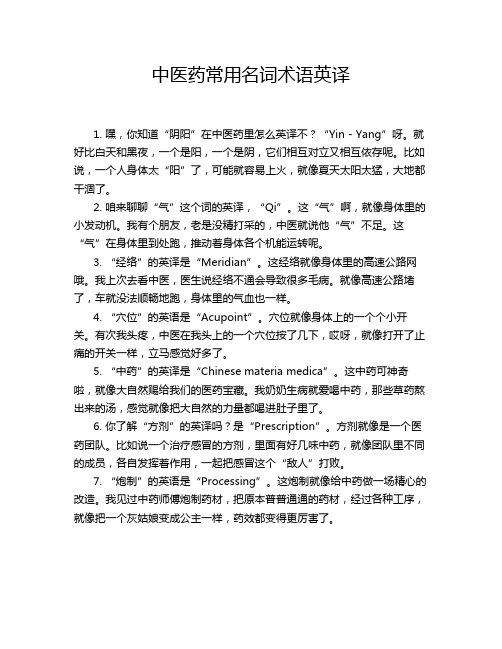
中医药常用名词术语英译1. 嘿,你知道“阴阳”在中医药里怎么英译不?“Yin - Yang”呀。
就好比白天和黑夜,一个是阳,一个是阴,它们相互对立又相互依存呢。
比如说,一个人身体太“阳”了,可能就容易上火,就像夏天太阳太猛,大地都干涸了。
2. 咱来聊聊“气”这个词的英译,“Qi”。
这“气”啊,就像身体里的小发动机。
我有个朋友,老是没精打采的,中医就说他“气”不足。
这“气”在身体里到处跑,推动着身体各个机能运转呢。
3. “经络”的英译是“Meridian”。
这经络就像身体里的高速公路网哦。
我上次去看中医,医生说经络不通会导致很多毛病。
就像高速公路堵了,车就没法顺畅地跑,身体里的气血也一样。
4. “穴位”的英语是“Acupoint”。
穴位就像身体上的一个个小开关。
有次我头疼,中医在我头上的一个穴位按了几下,哎呀,就像打开了止痛的开关一样,立马感觉好多了。
5. “中药”的英译是“Chinese materia medica”。
这中药可神奇啦,就像大自然赐给我们的医药宝藏。
我奶奶生病就爱喝中药,那些草药熬出来的汤,感觉就像把大自然的力量都喝进肚子里了。
6. 你了解“方剂”的英译吗?是“Prescription”。
方剂就像是一个医药团队。
比如说一个治疗感冒的方剂,里面有好几味中药,就像团队里不同的成员,各自发挥着作用,一起把感冒这个“敌人”打败。
7. “炮制”的英语是“Processing”。
这炮制就像给中药做一场精心的改造。
我见过中药师傅炮制药材,把原本普普通通的药材,经过各种工序,就像把一个灰姑娘变成公主一样,药效都变得更厉害了。
8. “辨证论治”的英译是“Treatment based on syndrome differentiation”。
这就像医生当侦探呢。
我去看中医,医生又是看舌头,又是把脉,然后判断我的“证”,再根据这个来治疗。
就像侦探根据线索破案一样精准。
9. “四气五味”的英语是“Four natures and five flavors”。
中药专业英语
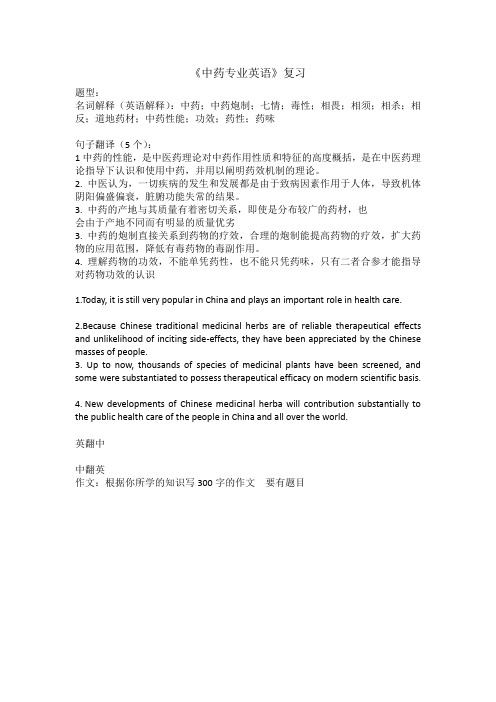
《中药专业英语》复习题型:名词解释(英语解释):中药;中药炮制;七情;毒性;相畏;相须;相杀;相反;道地药材;中药性能;功效;药性;药味句子翻译(5个):1中药的性能,是中医药理论对中药作用性质和特征的高度概括,是在中医药理论指导下认识和使用中药,并用以阐明药效机制的理论。
2. 中医认为,一切疾病的发生和发展都是由于致病因素作用于人体,导致机体阴阳偏盛偏衰,脏腑功能失常的结果。
3. 中药的产地与其质量有着密切关系,即使是分布较广的药材,也会由于产地不同而有明显的质量优劣3. 中药的炮制直接关系到药物的疗效,合理的炮制能提高药物的疗效,扩大药物的应用范围,降低有毒药物的毒副作用。
4. 理解药物的功效,不能单凭药性,也不能只凭药味,只有二者合参才能指导对药物功效的认识1.Today, it is still very popular in China and plays an important role in health care.2.Because Chinese traditional medicinal herbs are of reliable therapeutical effects and unlikelihood of inciting side-effects, they have been appreciated by the Chinese masses of people.3. Up to now, thousands of species of medicinal plants have been screened, and some were substantiated to possess therapeutical efficacy on modern scientific basis.4.New developments of Chinese medicinal herba will contribution substantially to the public health care of the people in China and all over the world.英翻中中翻英作文:根据你所学的知识写300字的作文要有题目。
中医术语英译

CHAPTER 1肝阳liver yang肝气liver qi肝开窍于眼liver open at the eyes肺开窍于鼻lung open at the nose心开窍于舌heart open at the tongue上亢ascendant hyperactivity肝阳上亢ascendant hyperactivity of liver yang阳盛yang exuberance阴盛yin exuberance阳衰yang debilitation阴衰yin debilitation传统医学traditional medicine中医traditional Chinese medicine中西医结合integration of Traditional Chinese and Western medicine 阴阳学说yin-yang theory五行学说five-phase theory中医基础理论basic theory of TCM中医诊断学traditional Chinese diagnostics方剂学formula study经方classified formula合方combined formula改方modified formula经络学说meridian and collateral (study) 经脉meridian vessel穴位acupuncture points头皮针scalp acupuncture耳针auricular acupuncture中药学traditional Chinese pharmacy中医养生traditional Chinese life nurturing 中医康复traditional Chinese rehabilitation 中医护理traditional Chinese nursing整体观念holism五脏five viscera六腑six bowelsCHAPTER 2精气学说essential qi theory肾精kidney essence清气clear qi清阳clear yang清热clear heat阳虚yang deficiency虚火deficiency fire血逆blood counterflow气逆qi counterflow过虑伤肺excessive anxiety damage the lung 气闭qi block热闭heat block阳脱证yang collapse pattern津脱fluid collapse补阳tonify yang补气tonify qi补血tonify blood苍天之气heaven qi气机qi dynamic陈腐之气stale qi气陷qi fall正气healthy qi气滞qi stagnation阳证yang pattern胃热证stomach heat pattern证型pattern type阴中之阴yin within yin阳中之阴yin within yang阴阳互根mutual rooting of yin and yang治本treat the root阴阳消长waxing and wanting of yin and yang月有阴晴圆缺the waxing and wanting of the moon 阴阳调和harmony of yin and yang气血不调disharmony of qi and blood调和气血harmonize the qi and the blood和胃harmonize stomach和法harmonizing method阳盛阴虚yin deficiency with yang hyperactivity表实exterior excess实寒excess cold虚实夹杂deficiency-excess complex表证exterior pattern表虚exterior deficiency里虚interior deficiency里实interior excess表里关系exterior-interior relation阴阳转化yin-yang conversion由实转虚conversion of excess into deficiency阴阳格拒yin and yang repulsion冷热格拒cold and heat repulsion阳邪yang pathogen阴邪yin pathogen五行five phases木行wood phase土生金earth engenders metal木生火wood engenders fire土克水earth restrains water木克土wood restrains earth木乘土wood overwhelms earth水乘火water overwhelms fire水侮土water rebels earth木侮金wood rebels metal金侮火metal rebels fire母子相及mother and child inter-affectingMother and child affecting each other CHAPTER 3先天之气innate qi先天之精innate essence后天之气acquired qi后天之精acquired essence肝肾同源homogeny of liver and kidney精血同源homogeny of essence and blood命门之火life gate fire气门qi gate君火sovereign fire / heart fire相火ministerial fire正气healthy qi宗气ancestral qi元气source qi原穴source point卫分defence aspect卫气defence qi运化transportation and transformation气化qi transformation气机失调qi dynamic disorder气机瘀滞qi dynamic stagnation寒凝气滞qi stagnation due to cold congealing 寒滞肝脉cold stagnating in the liver vessel 肝气上逆liver qi ascending counterflow胃气上逆stomach qi ascending counterflow 肝气横逆transverse invasion of liver qi真气genuine qi营气nutrient qi下气海lower sea of qi气化作用transformation function心血heart blood血瘀blood stasis气郁qi stagnation活血化瘀activate blood and resolve stasis营卫nutrient and defense营分nutrient aspect水谷精华the essence of water and food水谷代谢water-food metabolism津液fluid and humor津血同源homogeny of fluid and blood液脱证humor collapse pattern气液代谢qi-humor metabolism中气下陷sunken middle qi升举中气upraise middle qi心神heart spirit神昏spirit failing to keep to its abode三焦triple energizers脾气散精the spleen qi disperses essence肺主通调水道the lungs regulate the waterways 肾主水the kidneys dominate water肝主疏泄the liver dominates free coursing三焦主诸气the triple energizers dominate all qi肾主二便the kidneys dominate urination and defecation肺主宣发,主排汗和呼吸the lung govern sweat discharge and respiration魂ethereal soul精神essence-spirit意ideation魄corporeal soul志will气血失调disharmony of qi and blood阴阳失调disharmony of yin and yang气血两虚dual deficiency of qi and blood气阴两虚dual deficiency of qi and yin气病及血qi disease affecting the blood阳损及阴detriment to yang affecting yin气不摄血qi deficiency failing to control blood脾不统血spleen failing to control blood气不化津qi failing to transform fluidCHAPTER 4五脏five viscera中脏viscera stroke藏象viscera manifestation脉象pulse manifestation脏腑viscera and bowel六腑six bowels奇点extra point奇恒之腑extraordinary organs上焦upper energizers中焦middle energizers三焦tripple energizers心包经pericardium channel热入心包heat enters pericardium胆经gallbladder channel胆实热gallbladder excess heat小肠虚寒deficient cold of small intestine心热传入小肠transmission of heart heat to the small intestine 大肠虚寒deficient cold of large intestine热迫大肠heat distressing the large intestine膀胱气化bladder qi transformation膀胱湿热dampness heat of the bladder冷凝胞宫证pattern of cold congealing in the uterus热入血室heat entering the blood chamberBlood chamber is another name of uterus肝气犯胃liver qi invading the stomach风热袭肺wind-heat invading the lung火旺effulgent fire阴虚火旺yin deficiency with effulgent fire肺气失于宣发lung qi failing to diffuse肾精不足kidney essence insufficiency虚火上炎deficient fire flaming upward心火上炎heart fire flaming upward髓海sea of marrow血海sea of blood心胃火燔heart-stomach fire ablaze肝气郁滞liver qi depression化火transform into fire藏血store blood主疏泄govern free coursing少阳之气lesser yang qi心藏神heart houses spirit脾藏意spleen houses ideation热伤神明heat damaging bright spirit直中direct strike风中经络wind striking meridian and collateral 风中血脉wind striking blood vessels清热clear heat燥干清窍dryness affecting the clear orifices升清upbearing the clear泌别清浊separation of the clear and turbid湿浊dampness turbidity降浊downbear turbid降火downbear fire骨蒸潮热bone-steaming tidal fever肾主骨kidney govern the bone淤阻脑络证pattern of (blood) stasis obstructing the brain collateral 髓海sea of marrow髓通于脑marrow connects to the brain经脉collateral vessel血脉blood vessel二七天癸至heavenly tenth arrives at the age of 2 times 7七七天癸竭heavenly tenth fades away at the age of 7 times 7月经menstruation母乳喂养breastfeedingCHAPTER 5外因external cause内因internal cause不内外因cause neither internal nor external外邪external pathogen阴邪yin pathogen外感external contraction新感new contraction外感风寒external contraction of wind-cold外感六淫six-excess external contraction六淫入血分six excesses entering the blood aspect 暑湿summerheat dampness中暑summerheat stroke湿浊dampness turbidity下焦湿热lower energizer dampness-heat凉燥cool-dryness津枯血燥desiccation of liquid and blood dryness 温邪warm pathogen温下法warm purgation温毒pestilential pathogen瘟疫论treatise on pestilence婴儿惊厥(惊风)infantile convulsion刚痉febrile convulsion with chills暑邪summerheat肝风内动internal stirring of liver wind目上斜视upward squint of the eyes疮疡sores and ulcers内伤internal damage伤阳damage to yang伤津damage to fluid七情seven emotions情志不遂emotional upset喜极伤心excessive joy damaging the heart怒极伤肝excessive anger damaging the liver忧极伤肺excessive anxiety damaging the lung思极伤脾excessive thought damaging the spleen悲极伤肺excessive sorrow damaging the lung恐极伤肾excessive fear damaging the kidney惊极伤心excessive fright damaging the heart劳倦overexertion and fatigue寒厥cold syncope脏厥visceral syncope(内脏阳气衰微所致的肢厥,a syncope due to yang debilitation of internal organs)怒则气上anger causes qi to ascend喜则气缓joy causes qi to slacken悲则气消sorrow causes qi to disperse恐则气下fear causes qi to descend惊则气乱fright causes derangement of qi思则气结thought causes qi to bind忧则气郁anxiety causes qi to be depressed目赤bloodshot eyes五味偏嗜flavor predilection饮食偏嗜dietary predilection创伤学traumatology外伤traumatic injury房劳sexual overindulgence劳复taxation relapse女劳sexual taxation风痰wind-phlegm寒痰cold-phlegm痰饮phlegm-retained fluid痰湿phlegm-dampness水湿water-dampness淤血犯头static blood invading head 痿病wilting disease骨痿bone wilting筋痿sinew wilting绞痛colic pain寒疝cold abdominal colic淤痰blood stasis-phlegm浓痰purulent phlegm CHAPTER 6四诊four diagnostic examinations精神状态mental state面部表情facial expression面色complexion望小儿指纹vein of the infant's fingers 舌象tongue manifestation藏象visceral manifestation人体human body舌体tongue body舌形form of the tongue制剂形式preparation form舌态motility of the tongue口眼歪斜deviated of the tongue歪舌deviated tongue落枕stiff neck强硬舌stiff tongue震颤法trembling method颤动舌trembling tongue舌根root of the tongue舌尖tip of the tongue舌边margins of the tongue淡红舌pale red tongue淡白舌pale tongue红舌red tongue绛舌crimson tongue青舌blue tongue紫舌purple tongue青紫舌bluish purple tongue嫩舌tender-soft tongue胖大舌enlarged tongue肿胀舌swollen tongue瘦薄舌thin tongue点刺舌spotted tongue芒刺舌pricky tongue齿痕舌teeth-marked tongue裂纹舌fissured tongue痿软舌limp wilting tongue麻痹舌paralyzed tongue吐弄舌protruded agitated tongue 短缩舌contracted tongue地图舌geographical tongue舌苔tongue fur腻苔slimy fur滑苔slippery fur苔色fur color舌色tongue color中剥苔centre peeling fur根剥苔root peeling fur苔质texture of fur润苔moist fur燥苔dry fur燥裂苔dry and cracked fur前剥苔anterior peeling fur镜面舌mirror tongue类剥苔exfoliated fur淡红色薄白苔red tongue with thin white fur红舌薄黄干苔red tongue with thin, yellow and dry fur 命关life bar舌诊tongue diagnosis望舌inspection of the tongueCHAPTER 7口气mouth odor汗味sweat odor倒经inverted menstruation白带white vaginal discharge黄带yellow vaginal discharge恶露不下retention of the lochia恶露不绝persistent flow of lochia口臭fetid mouth odor halitosis把脉take pulse病脉morbid pulse三部九侯three positions and nine indicators 布指寸口脉wrist pulse寸口诊法wrist pulse-taking method人迎脉carotid pulse趺阳脉anterior tibial pulse寸,关,尺cun/inch, guan/bar and chi/cubit 诊尺肤cubit skin examination指法finger technique叩击法tapping technique举,按,寻lifting, pressing and searching 推寻pulse searching平脉tranquil pulse燥脉agitated pulse按诊body palpation按腧穴acupuncture point palpation病色morbid complexion病脉morbid pulse浮脉floating pulse孤阳上越deficiency yang floating upward 沉脉sunken pulse脾气下陷sunken spleen qi中气下陷sunken middle qi单按pressing with one finger总按simultaneous palpation浮脉floating pulse沉脉sunken pulse迟脉slow pulse数脉rapid pulse虚脉vacuous pulse实脉replete pulse洪脉surging pulse细脉fine pulse滑脉slippery pulse涩脉rough pulse弦脉string-like pulse结脉bound pulse相兼脉combined pulse芤脉hollow pulse散脉dissipated pulse革脉drumskin pulse伏脉hidden pulse牢脉firm pulse阳明腑证yang brightness bowel pattern 缓脉moderate pulse缓脉(不正常)relaxed pulse疾脉racing pulse大脉large pulse长脉long pulse濡脉soggy pulse弱脉weak pulse短脉short pulse微脉faint pulse动脉stirred pulse紧脉tight pulse代脉intermittent pulse促脉skipping pulse驱寒dissipate cold散瘀dissipate stasis风动stirring wing阴虚动风yin deficiency with stirring windCHAPTER 8问寒热inquiry about cold and heat问汗inquiry about sweating问痛inquiry about pain恶寒aversion to cold恶热aversion to heat发热恶寒aversion to cold with fever畏is usually translated as fear, as in "fear of cold" 畏寒但热不寒fever without chills但寒不热chills without fever潮热tidal fever午间潮热afternoon tidal fever日晡潮热late afternoon tidal fever骨蒸潮热bone-steaming tidal fever湿温潮热dampness-warm tidal fever阴虚潮热yin deficiency tidal fever微热mild fever微恶寒mild aversion to cold微寒mild chill微渴mild thirst身热不扬unsurfaced fever五心烦热vexing heat in the chest, palms and soles / five center heat手足烦热vexing heat in the extremities 手足厥冷reversal cold of the extremities 厥阴reverting yin寒热往来alternating chills and fever盗汗night sweating虚热deficiency heat少阳病lesser yang disease疟疾malaria头重脚轻heavy head and light feet身重heavy body重痛heavy pain目眩dizzy vision视力模糊blurred vision复视doubled vision灼痛scorching pain绞痛gripping pain掣痛pulling pain隐痛dull pain窜痛scurrying pain闷痛oppressive pain酸痛aching pain游走性疼痛wandering pain阵发性痛paroxysmal pain阵发性咳嗽paroxysmal cough持续性痛persistent pain汗不止persistent sweating项背拘急contracture of the nape and neck 四肢拘急contracture of the limbs肌肉痉挛muscle spasm淋病strangury disease血淋blood strangury热淋heat strangury胀痛distending pain刺痛stabbing pain冷痛cold pain空痛empty pain固定痛fixed pain胁痛hypochondriac四肢痛limb pain周身痛generalized pain完谷不化undigested food in the stool消化不良腹泻undigested food diarrhea 五更泻fifth-watch diarrhea五更咳fifth-watch cough溏泄sloppy diarrhea便溏sloppy stool大便硬结hard bound stool结脉bound pulse余尿不尽incomplete urination小便涩痛difficult painful urination大便失禁fecal incontinence小便失禁urinary incontinence尿浊turbid urine分泌清浊separation of the clear and turbid 语声重浊deep turbid voice小便淋沥dribbling urination癃闭dribbling urinary block遗精seminal emission梦遗dream emission白带white vaginal discharge黄带yellow vaginal discharge下消lower wasting-thirst里急后重tenesmus尿频frequent urination膀胱失约bladder retention failure遗尿enuresis阳痿impotence勃起erection滑精spermatorrhea早泄pre-mature ejaculation月经先期advanced menstruation月经period月经后期delayed menstruation月经先后无定期menstruation at irregular intervals 经期延长prolonged menstruation月经过多profuse menstruation月经过少scanty menstruation崩漏flooding and spotting闭经amenorrhea初潮menarche痛经dysmenorrhea赤白带下white and yellow vaginal discharge胸闷oppression in the chestCHAPTER 9半表半里证pattern of half-exterior half-interior表里辩证exterior-interior pattern identification表虚证exterior deficiency pattern表寒证exterior cold pattern风湿袭表证pattern of wind-dampness assailing the exterior 风寒袭喉证pattern of wind-cold assailing the throat风寒袭肺证pattern of wind-cold assailing the lung风寒束表wind-cold fettering the exterior风寒束肺证pattern of wind-cold fettering the lung卫表不固证defense-exterior insecurity pattern表里俱寒证pattern of dual exterior and interior cold肝胆俱实证pattern of dual excess of liver and gallbladder 气阴两虚证pattern of dual deficiency of qi and yin八纲辨证eight-principle pattern identification表寒里热证pattern of exterior cold and interior heat寒热错杂证cold-heat complex pattern虚实夹杂证deficiency-excess complex pattern上寒下热证upper cold and lower heat pattern上热下寒证upper heat and lower cold pattern上焦upper energizer上消upper waste-thirst热及生风证pattern of extreme heat engendering wind阴极似阳extreme yin resembling yang阳极似阴extreme yang resembling yin上盛下虚证upper exuberance and lower deficiency pattern 下焦lower energizer真虚假实证true deficiency with false excess pattern真实假虚证true excess with false deficiency pattern真寒假热证true cold with false heat pattern辩症syndrome differentiation阳虚痰凝yang deficiency with congealing phlegm寒凝气滞证pattern of congealing cold with qi stagnation寒凝胞宫证pattern of cold congealing in the uterus伤阳证yang damage pattern伤阴证yin damage pattern阴阳两虚证pattern of dual deficiency of yin and yang心脾两虚证pattern of dual deficiency of heart and spleen阴虚内热证pattern of yin deficiency of yin with internal heat 阴虚火旺证pattern of yin deficiency with effulgent fire阴盛阳衰证pattern of yin exuberance with yang debilitation 阳虚寒凝证pattern of yang deficiency with congealing cold 阴盛格阳证pattern of exuberant yin repelling yang阳盛格阴证pattern of exuberant yang repelling yin清阳不升证pattern of clear yang failing to ascend肾不纳气证pattern of kidney failing to receive qi脾不统血证pattern of spleen failing to manage blood八纲eight principles治疗原则therapeutic principle八纲治法eight principle therapeutic methods合证combined pattern合方combined formulaCHAPTER 10气陷证qi sinking pattern寒湿证cold-dampness pattern气机失调证qi dynamic disorder pattern气机郁滞证stagnant qi dynamic pattern湿热下注证pattern of dampness-heat pouring down寒凝气滞证pattern of congealing cold with qi stagnation寒凝血瘀证pattern of congealing cold with blood stasis寒湿内阻证pattern of internal obstruction of cold-dampness 气虚湿阻证pattern of qi deficiency with dampness obstruction 气机不利证inhibited qi dynamic pattern气虚水停证pattern of qi deficiency with water retention气虚不摄证pattern of qi deficiency with failure to constrain 气虚外感证pattern of qi deficiency with external contraction 蓄血证blood amassment pattern气血失调证qi-blood disharmony pattern气不摄血证pattern of qi failing to control the blood血虚挟淤证pattern of blood deficiency complicated by stasis 血虚寒凝证pattern of blood deficiency and congealing cold血虚风燥证pattern of blood deficiency and wind-dryness津气亏虚证fluid-qi deficiency pattern气滞水停证pattern of qi stagnation with water retention饮停胸胁证pattern of fluid retention in the chest and hypochondrium 风水相搏证pattern of mutual contention of wind and water水停证water retention pattern疫毒下注证pattern of pestilential toxin pouring downward火毒内陷证pattern of inward invasion of fire toxin表邪内陷证pattern of inward invasion of external evil表寒证exterior cold pattern表热证exterior heat pattern表虚exterior deficiency里实证interior excess pattern里寒interior cold里热interior heat外湿external dampness外风external wind外燥external dryness内风internal wind内燥internal dryness内湿internal dampness燥干清窍证pattern of dryness affecting the clear orifices气郁证qi depression pattern气郁化火证pattern of depressed qi transforming into fire 中气下陷证sunken middle qi脾气下陷sunken spleen qi直肠下陷prolapse of the rectum子宫下陷prolapse of uterus表气不固insecurity of exterior qi肾气不固insecurity of kidney qi蓄血blood amassment太阳蓄血证greater yang blood amassment pattern热入血室heat entering blood chamber寒入血室证pattern of cold entering blood chamber气虚血瘀证pattern of qi deficiency with blood stasis心血淤阻证heart blood stasis pattern寒凝血瘀证pattern of congealing cold with blood stasis 气病及血qi disease affecting the blood阳损及阴detriment to yang affecting yin生津engender fluid胃津stomach fluid津血同源homogeny of fluid and blood液脱证humor collapse pattern增液润肠increase humor and moisten the intestines风水相搏证pattern of mutual contention of wind and water阴虚水停证pattern of yin deficiency with water retention气滞水停证pattern of qi stagnation with water retention太阳蓄水证greater yang water retention pattern胸胁胀痛fullness in the chest and hypochondrium水停胸胁证pattern of fluid retention in the chest and hypochondrium。
中医英语翻译常用词汇英汉对照

自然现象 哲学概念 对立统一 相互消长
邪正关系
healthy qi 发热恶寒 fever and aversion to cold
头身疼痛 久痢脱肛 dysentery 养阴清热 heat 清肺热 湿邪犯肺 lung 清热泻火 fire 腠理
headache and body pain proctoptosis due to prolonged
气血运行 阴阳转化 yang 阳消阴长 阴胜则阳病
yang waning and yin waxing predominance of yin leading to
disorder of yang 阴胜则阳病 an excess of yin leads to
deficiency of yang 阳胜则热 heat 寒极生热 热极生寒 阳损及阴 extreme cold generating heat extreme heat generating cold impairment of yang involving yin predominance of yang generating
essence and blood 肝阳上亢 心肝血虚 hyperactivity of liver yang asthenia / deficiency of heart and
liver blood 心肝火旺 心火亢盛 滋肾养肝 方位配五行 exuberance of heart and liver fire hyperactivity/exuberance of heart fire nourishing the kidney and liver correspondence of the directions to
医疗实践 治疗原则 寒凉药物
常见中医术语英文翻译及中文释义
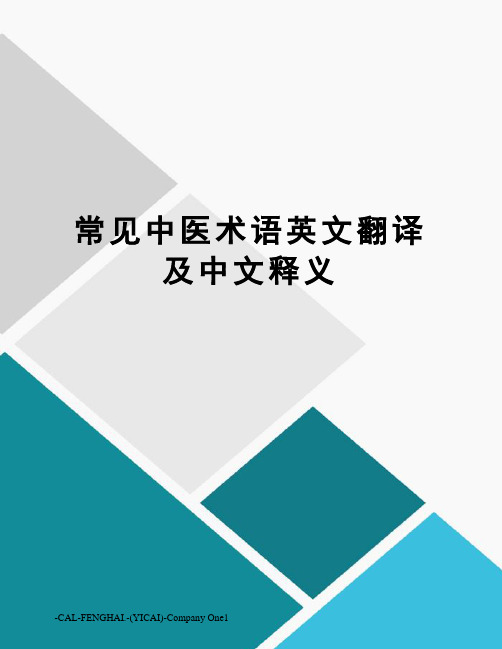
常见中医术语英文翻译及中文释义-CAL-FENGHAI.-(YICAI)-Company One1郑州市管城中医院肿瘤科整理常见中医术语英文翻译及中文释义常见中医术语英文翻译及中文释义中医术语的中英文参考对照治则 principle of treatment 在对临床的具体立法、处方、用药等具有普遍的指导意义,因而在治疗疾病时必须遵循的基本原则。
治病求本 treatment aiming at its pathogenesis 针对产生疾病的根本原因进行治疗的原则。
急则治标 symptomatic treatment in acute condition 与缓则治本相对而言,在大出血、暴泻、剧痛等标症甚急的情况,及时救治标病。
缓则治本 radical treatment in chronic case 与急则治标相对而言,针对病势缓和、病情缓慢的情况,从本病的病机出发,采取调理、补益为主的治疗原则。
标本兼治 treating both manifestation and root cause of disease 针对病证出现的标本并重的情况,采用治标与治本相结合的治疗原则。
治未病 preventive treatment of disease 采取一定的措施防止疾病产生和发展的治疗原则,包括未病先防和既病防变两个方面。
同病异治 treating same disease with different methods 表现相同的病证,可因人、因时、因地的不同,或由于病情的发展、病机的变化、病型的各异、正邪消长等差异,采取不同治法的治疗原则。
异病同治 treating different diseases with same method 表现不同的病证,由于发病机理相同,采取相同治法的治疗原则。
因时制宜 treatment in accordance with seasonal conditions 考虑到时令气候寒热燥湿的不同而选择适宜的治法、方药的治疗原则。
中医英语翻译常用词汇英汉对照

交替搓揉alternative rubbing and kneading
旋转复位rotating reduction
腰肌劳损injury of lumbartissues
针刺的角度与深度angle and depth of needling
提插捻转lifting, thrusting, swirling and rotating
双手进针法insertion of needle with double hands
水针疗法hydro-acupuncture therapy
中医英语翻译常用词汇(cíhuì)英汉对照
中草药Chinese medicinal herbs
炮制processing
四气五味four properties and five tastes
清除杂质eliminating impurity
入药部分the part used for medical purpose
减轻疼痛alleviating pain
艾炷灸moxibustion with moxa cone
功法训练exercise for practicing tuina
灯火灸lamp moxibustion
放松肌肉relaxing muscles
温针灸warm needling method
解除肌肉紧张relieving muscular tension
配伍关系compatibility
燥湿健脾drying dampness and strengthening the spleen
组成规律prescription-formulating principle
中医英语术语翻译

中医英语术语翻译(总5页)--本页仅作为文档封面,使用时请直接删除即可----内页可以根据需求调整合适字体及大小--Unit 11 中国医药学traditional Chinese medicine; TCM2中医基础理论basic theory of traditional Chinese medicine3临床经验clinical experience4辨证论治treatment based on syndrome differentiation5杂病miscellaneous diseases6中药学Chinese pharmacy7四气五味four properties and five tastes8针灸acupuncture and moxibustion; acumox9古代中国哲学classical Chinese philosophy10汗法sweating therapy; diaphoresis11下法purgation12吐法vomiting therapy; emetic therapy13补土派the School of Reinforcing the Earth14病因学etiology15方剂prescription; formula16医疗实践medical practice17治疗原则therapeutic principles18寒凉药物herbs cold and cool in nature19滋阴降火 nourishing yin and reducing fire20瘀血治病diseases caused by blood stagnationUnit21五脏five zang-organs; five zang-viscera2六腑six fu-organs3经络系统system of meridians and collaterals4整体观念holism5有机整体organic wholenss6社会属性social attribute7开窍(of the five zang-organs) open into8生长化收藏sprout, grow, transform, ripen and store9诊断学diagnostics10邪正关系relationship between pathogenic factors and healthy qi11治疗学therapeutics12风寒感冒common cold due to wind and cold13同病异治different therapeutic methods used to treat the same disease14异病同治the same therapeutic method used to treat different diseases15水液代谢平衡balance of water metabolism16清心火clearing away heart fire17疾病本质nature of disease18以左治右treating the left side for curing diseases located on the right side19从阴引阳drawing yang from yin20.病在上者下取之treating the lower part for curing diseases located on the upper part Unit 31哲学概念philosophical concept2.相互转化mutual transformation3.阴平阳秘balance of yin and yang4.阴阳转化transformation between yin and yang5.寒极生热extreme cold turning into heat6.病理变化pathological changes7.绝对偏盛absolute predominance8.病机总纲general rule of pathogenesis9.补其不足supplementing what it lacks of10.祛风散寒 eliminating wind and dispersing cold11.相互消长 mutually inhibiting and promoting;wax and wane between yin and yang12.相互制约 mutually inhibiting and restraining13.相互依存 interdependence14.阴胜则阳病excess of yin leading to decline of yang15.相反相成 contrary and supplementary to each other16.有机整体 organic whole17.阳损及阴 impairment of yang involving yin18.阴阳两虚 deficiency of both yin and yang19.虚寒证deficiency cold syndrome20.潜阳熄风 suppressing yang and eliminating windUnit41 the theory of five elements 五行学说2 free development 条达舒畅3 to be generated and to generate生我,我生4 restraint in generation 生中有制5 over restriction and counter-restriction相乘相侮6 Wood over restricts earth because it is deficient.土虚木乘7 promotion, restriction, inhibition and transformation 生克制化8 disorder of a mother-organ involving its child-organ 母病及子9 insufficiency of essence and blood in the liver and kidney 肝肾精血不足10 blood deficiency in the heart and liver 心肝血虚11 exuberant fire in the heart心火亢盛12 insufficiency of liver yin 肝阴不足13 declination of kidney yang肾阳式微14 weakness of the spleen and stomach 脾胃虚弱15 soothing the liver and harmonizing the stomach 平肝和胃16 between water and fire水火不济Unit51 藏象学说doctrine of visceral manifestations2 五脏六腑five zang-organs and six fu-organs3 奇恒之腑extraordinary fu-organs4 水谷精 of water and food5 传化水谷transmitting and transforming water and food6 贮藏精气storing essence7 表里关系internal and external relationship8 治疗效应therapeutic effects9 临床实践clinical practice10 藏而不泻storage without discharge11泻而不藏discharge without storage12形体诸窍physical build and various orifices13开窍(of five zang-organs) open into14精神情志spirit and emotions15心藏神the heart storing spirit16肺藏魄the lung storing corporeal soul17肝藏魂the liver storing ethereal soul18脾藏意the spleen storing consciousness19肾藏志the kidney storing will20其华在面the luster manifesting upon the faceUnit61 心主血脉 the heart governing blood and vessels2 心气充沛 sufficiency of heart qi3 面色红润 rosy complexion4 血液充盈 sufficiency of blood5 脉道不利 unsmooth vessels6 面色无华 lusterless complexion7 脉象细弱 thin and weak pulse8 心藏神 the heart storing spirit9 汗血同源 sweat and blood sharing the same origin10 升降出入 ascending, descending, going out and going in11宣发肃降 dispersion, purification and descent12通调水道 regulating water passage13脾主运化 the spleen governing transportation and transformation 14水谷精 of water and food15水液停滞 stoppage of water and fluid16后天之本 acquired base of life17调畅气机 regulating qi activity18肝气逆上 upward adverse flow of liver qi19先天之精 innate essence20肾主纳气 the kidney receiving qiUnit71 奇恒之府extraordinary fu-organs2 孤俯isolated fu-organ3 腐熟水谷digest water and food4 魄门anus5 肝之余其surplus part of liver qi6 上焦upper energizer7 泌别清浊separating the lucid from the turbid8 食物残渣residue of foods9 大肠主津The large intestine governs thin body fluid10精汁(胆汁)bile11小肠主液The small intestine governs thick body fluid12初步消化primary digestion13精气essential qi14七冲门the seven important portals15胆主决断The gallbladder is responsible for making judgment16排泄糟粕discharge waste17月经来潮occurrence of menstruation18吸门inhaling portal19形态中空morphological hollowness20传化水谷transporting and transforming water and foodUnit81 先天禀赋innateness2 精微物质nutrients; refined substance3 血液循行blood circulation4 水液代谢water metabolism5 气的运动形式way of qi movement6 气的升降出入ascending, descending, exiting and entering movements of qi7 气机调畅normal function of qi activity8生命的原动力primary motive force of life9 温养腑脏warming and nourishing the viscera10 腑脏经络之气qi of the viscera and meridians11气机qi activity12气化qi transformation13先天之气innate qi14后天之气acquired qi15正气healthy qi16邪气pathogenic factors17元气primordial qi18宗气thoracic qi19营气nutritive qi20卫气defensive qi21腠理striae and intersticesUnit91气生血qi promoting the production of blood2气行血qi promoting the flow of blood3气摄血qi commanding blood4血载气blood carrying qi5血生气blood generating qi6气生津液qi promoting the production of body fluid7气行津液qi promoting the flow of body fluid8气摄津液qi commanding body fluid9津液载气body fluid carrying qi10津液生气body fluid generating qi11津血同源body fluid and blood sharing the same origin12气随液脱exhaustion of qi due to loss of body fluid13气随血脱exhaustion of qi due to hemorrhage14气随津泄loss of qi due to profuse sweating15气行则血行,气滞则血瘀。
中医专业英语课后短语及句子翻译

Unit1Test A1.differentiating syndromes and treatment 辨证论治2.syndrome differentiation with eight principles 八纲辨证3.location of diseases 病变部位4.tendency of pathological changes 病势5.external disease factors 外感病邪6.duration of a disease 病程7.aversion to cold 恶寒8.nasal congestion 鼻塞9.sore,itchy throat 喉痒咽痛10.penetrate from the superficial layers to the interior of the body 由表传里11.changes in tongue coating 舌苔变化12.cold limbs 四肢厥冷13.pallor/pale face 面色苍白14.clear and copious urine 小便清长15.absence of thirst 口不渴16.primary disease 原发病17.pale tongue with white coating 舌淡苔白18.malar flush 颧红19.struggle between the anti-pathogenic factors and pathogenic factors 正邪相争20.yang/yin depletion/collapse 亡阳/亡阴21.reduced appetite 食欲减退22.abdominal distention 腹部胀满23.qi transformation 气化24.pseudo-cold and real heat 真寒假热二句子翻译1.The clinical manifestations of diseases, though intricate, can be analyzed with the eight principles according to the category, location and nature of disease as well as the conflict between the anti-pathogenic factors and pathogenic factors.疾病的临床表现尽管错综复杂,但基本上都可以用八纲从疾病的类别、病性、邪正盛衰方面进行分析。
中医专业词汇英文译法
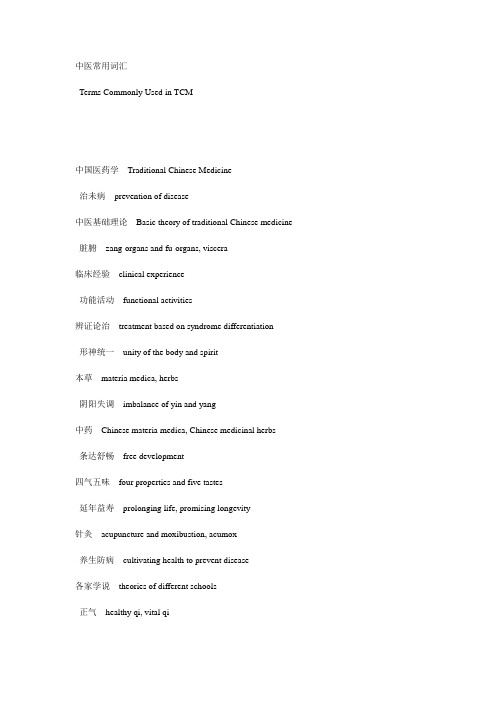
中医常用词汇Terms Commonly Used in TCM中国医药学Traditional Chinese Medicine治未病prevention of disease中医基础理论Basic theory of traditional Chinese medicine 脏腑zang-organs and fu-organs, viscera临床经验clinical experience功能活动functional activities辨证论治treatment based on syndrome differentiation形神统一unity of the body and spirit本草materia medica, herbs阴阳失调imbalance of yin and yang中药Chinese materia medica, Chinese medicinal herbs条达舒畅free development四气五味four properties and five tastes延年益寿prolonging life, promising longevity针灸acupuncture and moxibustion, acumox养生防病cultivating health to prevent disease各家学说theories of different schools正气healthy qi, vital qi汗法diaphoresis, sweating therapy病邪pathogenic factor下法purgative therapy, purgation整体观念concept of holism吐法emetic therapy, vomiting therapy疾病的本质与现象nature and manifestations of disease补土派school of invigorating the earth阴阳的相对平衡relative balance between yin and yang病因学说etiology疾病的发生与发展occurrence and development of disease 养生health-cultivation,同病异治treating the same disease with different therapies 医疗实践medical practice异病同治treating different diseases with the same therapy 治疗原则therapeutic principles五脏five zang-organs, five zang-viscera寒凉药物herbs of cold and cool nature, cold-natured herbs 六腑six fu-organs, six fu-viscera滋阴降火nourishing yin to lower/reduce fire经络系统system of meridians and collaterals滋水涵木enriching water to nourish wood余热未尽incomplete abatement of heat瘀血致泻disease caused by blood stasis有机整体organic wholeness/integrity先天之精congenital essence表里关系exterior and interior relation形与神俱inseparability of the body and spirit开窍opening into开胃promoting appetite自然现象natural phenomena脉象pulse conditions, pulse pattern哲学概念philosophical concept邪正关系states of pathogenic factors and healthy qi对立统一unity of opposites发热恶寒fever and aversion to cold相互消长mutual waning and waxing头身疼痛headache and body pain相互转化mutual transformation久痢脱肛proctoptosis due to prolonged dysentery阴阳属性nature of yin and yang养阴清热nourishing yin and clearing away heat相互联系interrelation清肺热clear away lung-heat相互制约mutual restraint, mutual restriction/interaction湿邪犯肺pathogenic dampness invading the lung动态平衡dynamic equilibrium清热泻火clearing away heat and reducing fire阴平阳秘yin and yang in equilibrium腠理muscular interstices, striae, interstitial space阴阳的互根互用interdependence of yin and yang水湿停滞retention of water and dampness, water retention 相互依存interdependence癃闭retention of urine阴阳离绝separation of yin and yang气血运行circulation/flow of qi and blood相反相成opposite and supplementary to each阴阳转化transformation between yin and yang生理功能physiological functions阳消阴长yang waning and yin waxing病理变化pathological changes阴胜则阳病predominance of yin leading to disorder of yang 临床诊断clinical diagnosis阴胜则阳病an excess of yin leads to deficiency of yang阳胜生外热exuberance of yang leading to exterior heat阳胜则热predominance of yang generating heat阳中求阴obtaining yang from yin寒极生热extreme cold generating heat绝对偏盛absolute predominance热极生寒extreme heat generating cold阳虚则寒yang deficiency leading to cold阳损及阴impairment of yang involving yin阴阳俱损simultaneous consumption of yin and yang阴液不足insufficiency of yin-fluid阴阳两虚simultaneous deficiency of both yin and yang病机总纲general principle of pathogenesis阳虚发热fever due to yang deficiency病机pathomechanism, pathological mechanism阴阳自和natural harmony between yin and yang阴阳胜复alternative predominance of yin and yang木乘土the wood over-restrains the earth虚寒证deficiency-cold syndrome木火刑金wood-fire impairs the metal扶阳退阴strengthening yang to reduce yin金水相生generation between the metal and water祛风散寒expelling/eliminating wind to dispersing cold生克制化interrelationship between generation and restriction 消导积滞promoting digestion and removing food retention制则生化restriction ensuring generation潜阳熄风suppressing yang to quench wind母病及子disease of the mother-organ affecting the child-organ五行学说theory of five elements传变transmission of disease, progress of disease运动变化motion and variation子病犯母disease of the child-organ affecting the mother-organ正邪相争struggle/combat between healthy qi and pathogenic factors 肝肾精血不足insufficiency of liver and kidney essence and blood 相生相克mutual generation and restriction肝阳上亢hyperactivity of liver yang生我,我生to be generated and to generate心肝血虚asthenia / deficiency of heart and liver blood克我,我克to be restricted and to restrict心肝火旺exuberance of heart and liver fire生中有制restriction within generation心火亢盛hyperactivity/exuberance of heart fire克中有生generation within restriction滋肾养肝nourishing the kidney and liver木曰曲直wood is characterized by growing freely and peripherally 方位配五行correspondence of the directions to the five elements 火曰炎上fire is characterized by flaming up温肾健脾warming the kidney and strengthening the spleen土爰稼穑earth is characterized by cultivation and reaping肾阳式微declination of kidney yang金曰从革metal is characterized by change脾阳不振inactivation of spleen yang病缓起gradual onset of disease脾胃虚弱hypofunction/weakness of the spleen and stomach 肝阴不足insufficiency of liver yin地道不通menopause相乘相侮over-restriction and reverse restriction平肝和胃soothing the liver and harmonizing the stomach 水湿停聚retention of water-dampness水火不济discordance between water and fire肾阴不足insufficiency of kidney yin藏象学说theory of visceral manifestations心肾不交disharmony between the heart and kidney奇恒之腑extraordinary fu-organs宣通水道dredging water passage水谷精微cereal nutrients, essence of water and food通调水道dredging and regulating water passage传化水谷transmission and transformation of food行气利水activating qi to excrete water贮藏精气storage of essence水液停滞retention of fluid治疗效果curative / therapeutic effect后天之本postnatal / acquired base of life藏而不泻storage without excretion调畅气机regulating qi activity泻而不藏excretion without storage肝气上逆upward flow of liver qi表热里寒exterior heat and interior cold水曰润下water is characterized by moistening and downward flowing肝旺脾虚hyperfunction of the liver and weakness of the spleen医.学.全.在线.网.站.提供脾主运化the spleen governing transportation and transformation大肉陷下obvious emaciation and muscular atrophy, extreme emaciation肝气郁结stagnation of liver qi面色红润ruddy complexion, rosy cheeks胆虚证gallbladder deficiency syndrome胆虚不得眠insomnia due to gallbladder asthenia腐熟水谷digesting food导便法laxation食欲不振poor appetite跌打损伤traumatic injury脘腹胀闷epigastric distension and depression动静结合integration of motion and quietness/stillness嗳气酸腐eructation with fetid odor定喘relieving asthma泌别清浊separating the clear from the turbid心主血脉the heart controlling blood and vessels食物残渣residue of food心气充沛abundance of heart qi大肠主传导the large intestine governing transmission and transportation 防御外邪入侵preventing the invasion of exogenous pathogenic factor 癃闭dysuria, retention of urine, anuria and dysuria血液充盈plenty of blood面黄肌瘦emaciation with sallow complexion脉道不利unsmoothness of vessels止珠偏斜strabismus, squint, ocular deviation面色无华lusterless complexion调节水液regulation of water脉象细弱thin and weak pulse排泄糟粕excretion of waste material面色萎黄sallow complexion髓海不足insufficiency of marrow-sea汗血同源sweat and blood sharing the same origin精神委靡dispiritedness, listlessness, lower spirit升降出入ascending, descending, coming in and going out月经不调irregular menstruation气为血帅qi serves as the commander of the blood冲任不固weakness of thoroughfare and conception vessels气血凝滞stagnation of qi and blood经期延长prolonged menstruation血瘀blood stasis小肠实热sthenia-heat in the small intestine气滞腰痛lumbago due to qi stagnation气机调畅smooth activity of qi气虚滑胎habitual abortion due to qi asthenia该文章转载自医学全在线:/yingyu/2008/23228.shtml。
- 1、下载文档前请自行甄别文档内容的完整性,平台不提供额外的编辑、内容补充、找答案等附加服务。
- 2、"仅部分预览"的文档,不可在线预览部分如存在完整性等问题,可反馈申请退款(可完整预览的文档不适用该条件!)。
- 3、如文档侵犯您的权益,请联系客服反馈,我们会尽快为您处理(人工客服工作时间:9:00-18:30)。
Unit1Test A1.differentiating syndromes and treatment 辨证论治2.syndrome differentiation with eight principles 八纲辨证3.location of diseases 病变部位4.tendency of pathological changes 病势5.external disease factors 外感病邪6.duration of a disease 病程7.aversion to cold 恶寒8.nasal congestion 鼻塞9.sore,itchy throat 喉痒咽痛10.penetrate from the superficial layers to the interior of the body 由表传里11.changes in tongue coating 舌苔变化12.cold limbs 四肢厥冷13.pallor/pale face 面色苍白14.clear and copious urine 小便清长15.absence of thirst 口不渴16.primary disease 原发病17.pale tongue with white coating 舌淡苔白18.malar flush 颧红19.struggle between the anti-pathogenic factors and pathogenic factors 正邪相争20.yang/yin depletion/collapse 亡阳/亡阴21.reduced appetite 食欲减退22.abdominal distention 腹部胀满23.qi transformation 气化24.pseudo-cold and real heat 真寒假热二句子翻译1.The clinical manifestations of diseases, though intricate, can be analyzed with the eight principles according to the category, location and nature of disease as well as the conflict between the anti-pathogenic factors and pathogenic factors.疾病的临床表现尽管错综复杂,但基本上都可以用八纲从疾病的类别、病性、邪正盛衰方面进行分析。
2.The differentiation of the exterior/interior syndromes is a relatively simple one preliminary to the other principles.与别的辩证原则相比,辨别表里是第一步,而且比较简单。
3.Interior syndromes are often associated with chronic diseases.They are characterized by high fever, aversion to heat, restlessness, thirst, scanty and brownish urine, constipation, reddish tongue with yellowish fur and rapid pulse.里证常与慢性疾病有关,通常表现为以下症状:高烧、恶热、烦躁不安、口渴、小便短赤、大便秘结、舌红苔黄、脉数等。
4.A clear understanding of the cold and heat syndromes is of great significance for identifying the nature of a disease and guiding the treatment.辨别寒证与热证,对于认识疾病的性质和指导治疗有着重要的意义5.Excess refers to excessive pathogenic factors and deficiency refers to deficientanti-pathogenic factors (healthy qi), thus excess and deficiency are two principles summarizing and discriminating the predominance and decline of the two polar factors.实证主要指邪气盛实,虚证主要指正气不足,所以实与虚是用以概括和辨别邪正盛衰的两个纲领。
Unit 21.in concrete practice 在具体操作中2.data collection 数据采集3.the first level of inspection 望诊的第一步4.rosy cheek 红润的面颊5.eye contact 目光交流6.favorable prognosis 预后良好7.dull in response 反应迟钝8.heavy in body motion 身重9.slight illness 身体不舒服10.visual diagnosis 望诊11.regain health 恢复健康12.core substances 核心物质13.overall impressions 总体印象14.beyond the examination of SHEN 除望神外15.in an unbalanced state 处于失衡状态16.no coat/absence of coat 无苔17.greasy coating 苔腻18.course of an illness 病程19.be responsible for transportation and transformation 主运化20.indicative of 表现为21.long-standing disharmony 长期失调22.the underside of the tongue 舌下23.circulatory system 循环系统24.blood stagnancy 血瘀二句子翻译1.Inspection is a visual diagnosis made by a physician to determine the patient’s health condition and identify the disorders. It is one of the Four Diagnostic Technigues in Chinese medicine practice.望诊是医生用眼睛对病人进行观察医疗接病人的健康状况、进而推断病情的一种诊察方法,是中医四诊之一。
2.False vitality is seen in patients suffering from prolonged and severe diseases with extremely declined essence and qi. It is sudden and momentary ,like‘the last radiance of the setting sun’, as described by the ancient people.假神见于久病重病、精气极度衰弱之人,一般比较突然、短暂,古人喻为“回光返照”。
plexion could be varied due to different constitution, geographical environment, seasons, weather and occupation.由于个人体质、地区环境、季节、天气和职业等差别,个人肤色也不尽相同。
4.A normal tongue is seen as soft, flexible and slightly red with proper size, thin white moist coating evenly distributed on it.正常舌主要表现为舌体柔软,运动自如,色淡红,大小适中,苔薄白均匀铺于舌面。
5.A stiff tongue shows blockage in the meridians and collaterals, and is usually seen in cases of apoplexy or a precursor to it.僵硬舌多为经络阻滞,属中风或中风先兆。
Unit 31.tonify kidney yang 温补肾阳2.dispel cold 祛寒3.warm meridians 温经4.five-element(phase)model/theory 五行学说5.four properties 四气6.five tastes 五味7.lifting, lowering, floating, or sinking 升降浮沉8.alleviate spasmodic pain 缓急止痛9.clearing heat and purge fire 清热泻火10.warm the interior 温里11.strengthening yang 壮阳12.reverse the upward motion of qi 降气13.drying dampness 燥湿14.superficial wing heat syndrome 外感风热证15.herbal dispensary/shop 中药店16.stagnant blood syndrome 血瘀证17.activate qi and blood motion 行气活血18.yang deficiency syndrome 阳虚证19.Galenical medicine 盖仑制剂(草药制剂)20.softening and eliminating swellings and masses 软坚散结二句子翻译1.He ascribed his failure of treatment to misdiagnosis.他把治疗失败归因于诊断错误。
2.Tears are constantly produce to lubricate the movement of the eyes.不断产生的眼泪起到润滑眼睛的作用。
3.Chinese medical researchers have successfully developed a new medicine to alleviate the cancer patients’ suffering.中国医学研究人员已成功研制出一种新药来缓解癌症病人痛苦。
